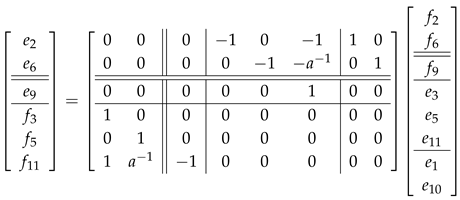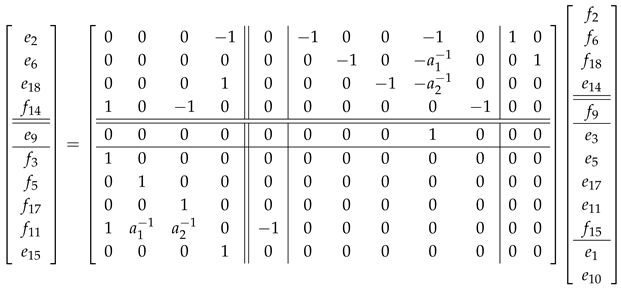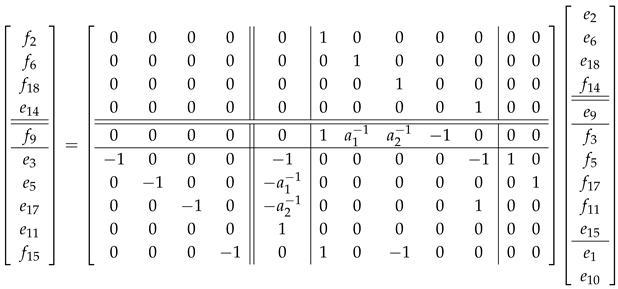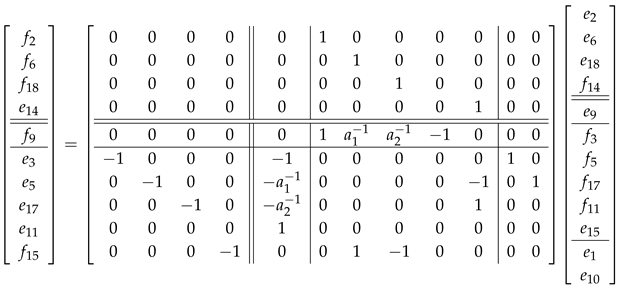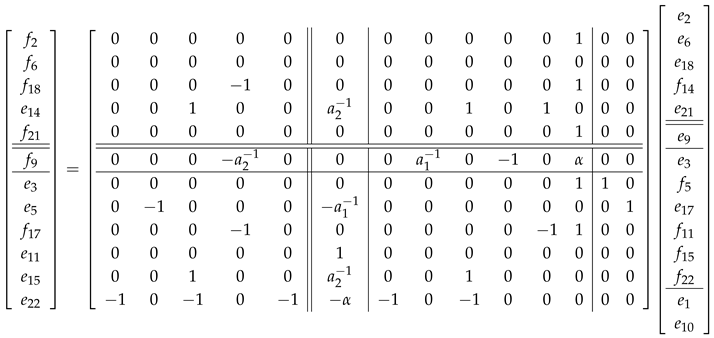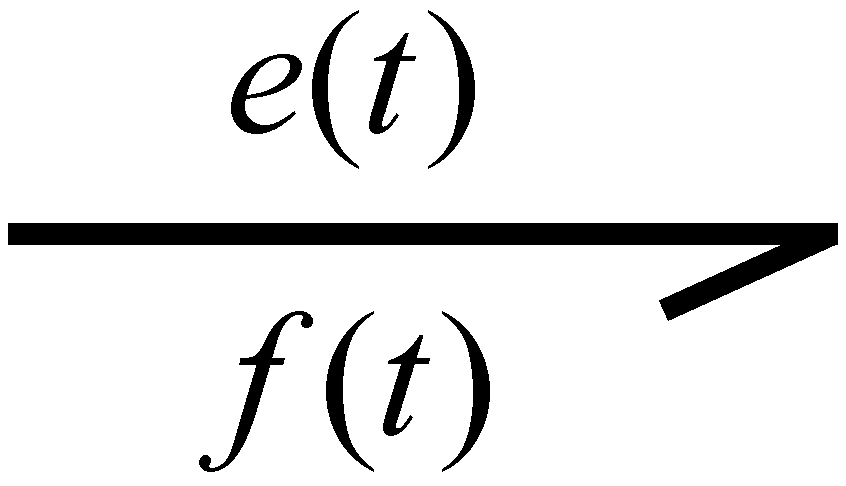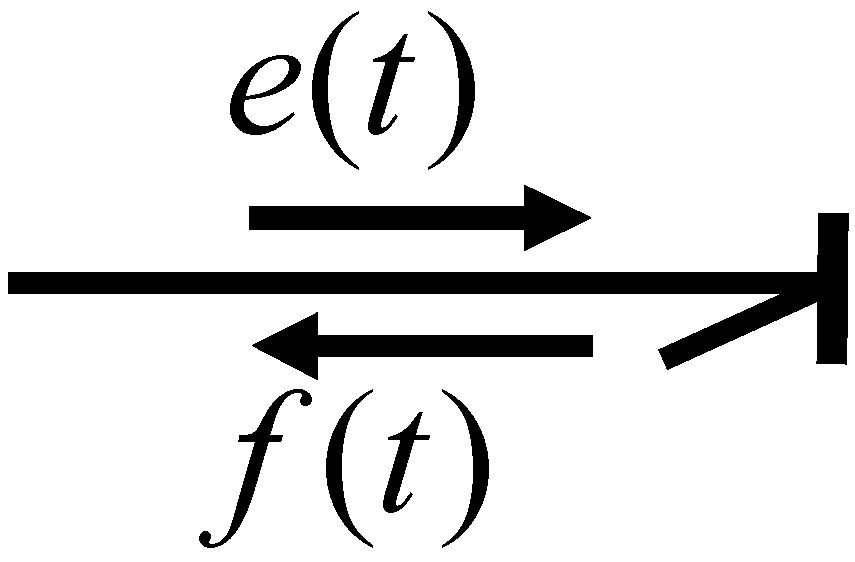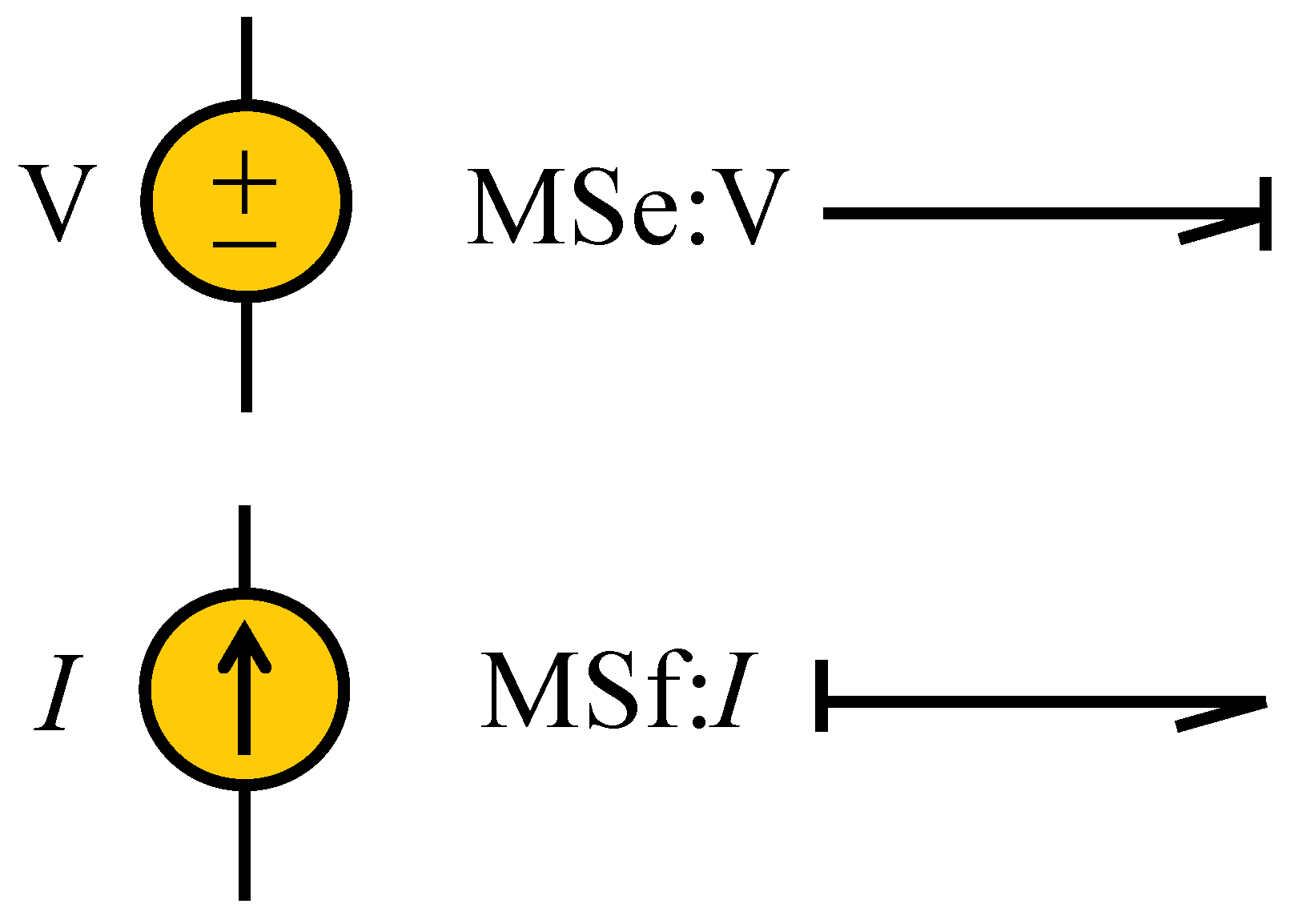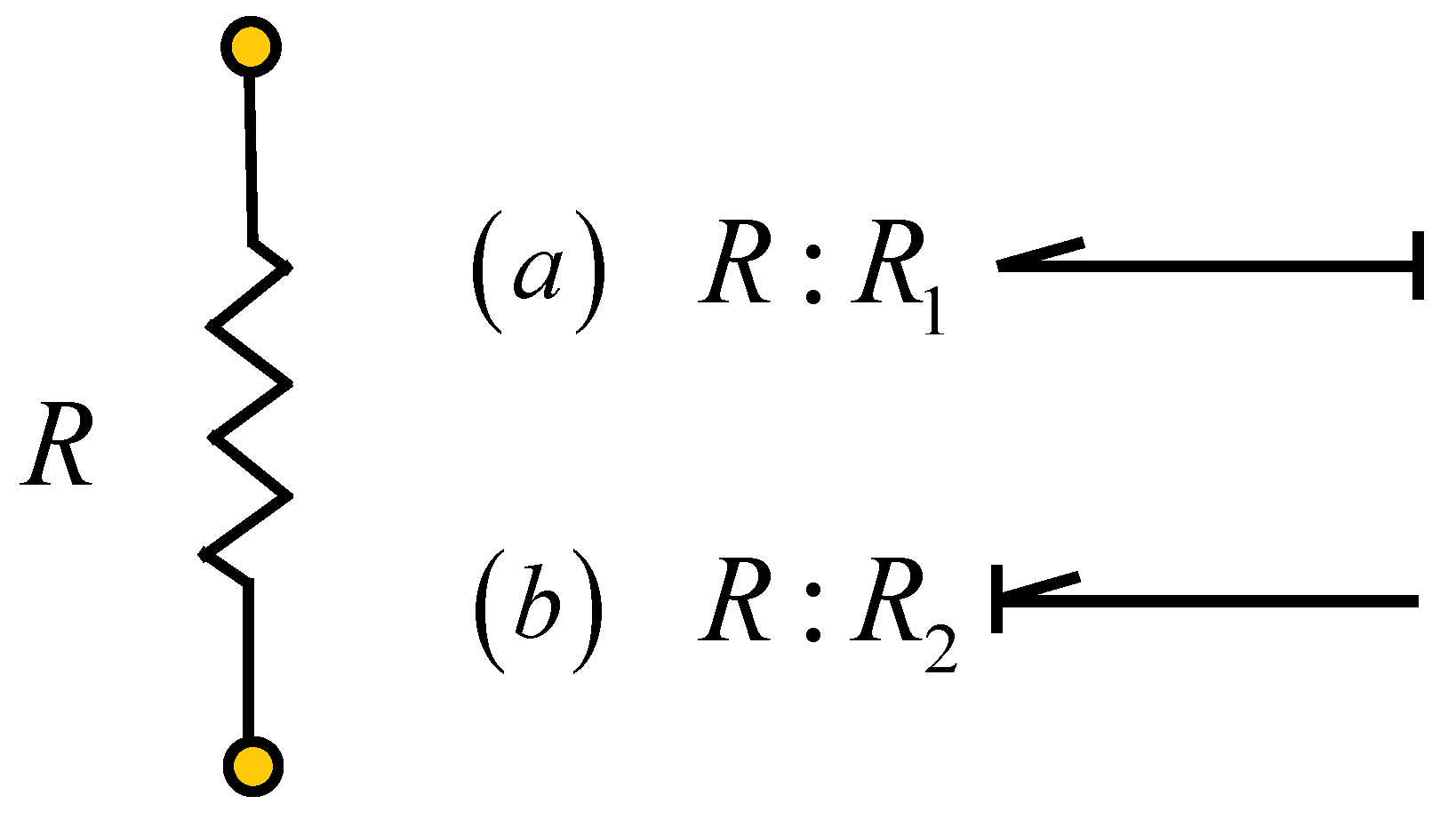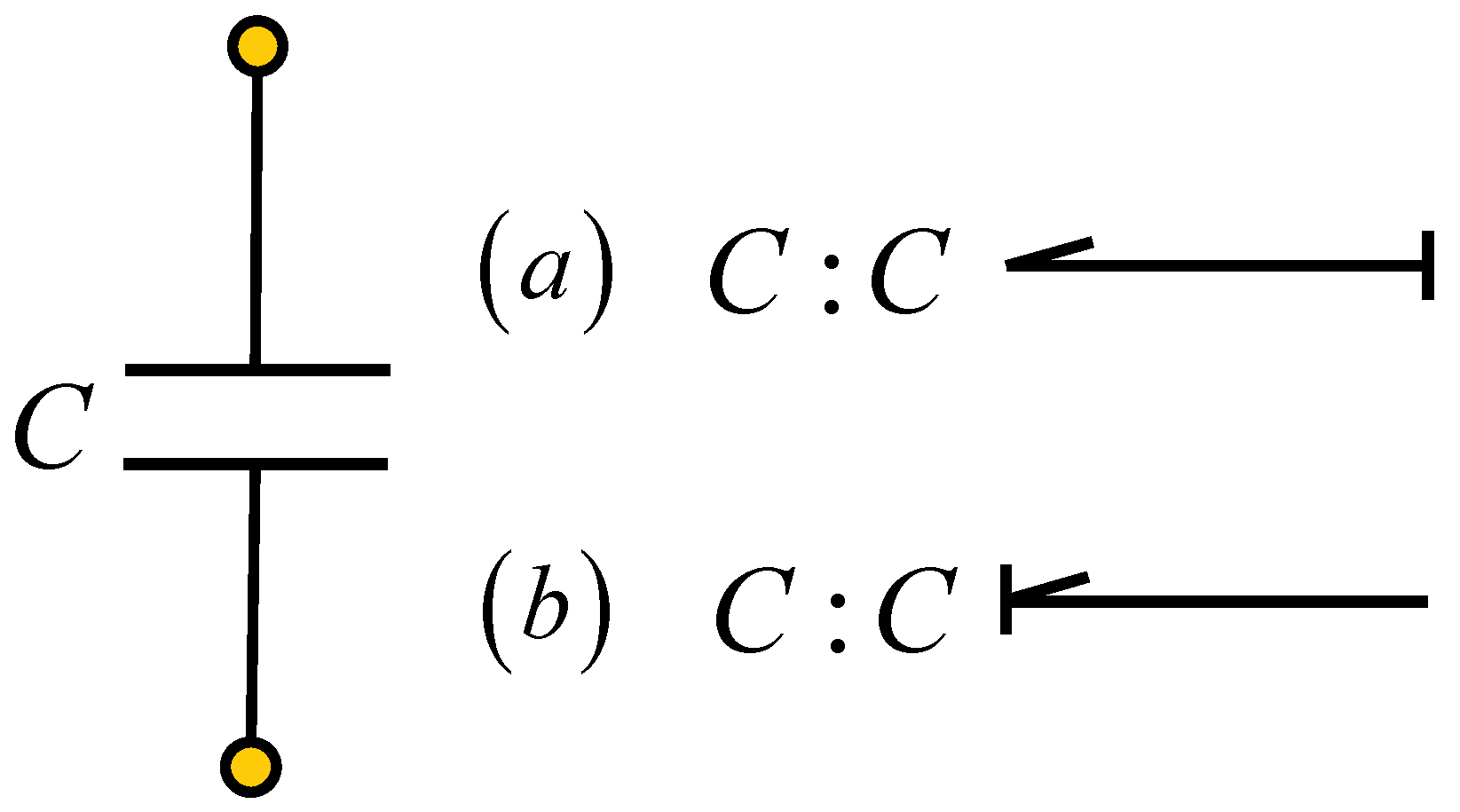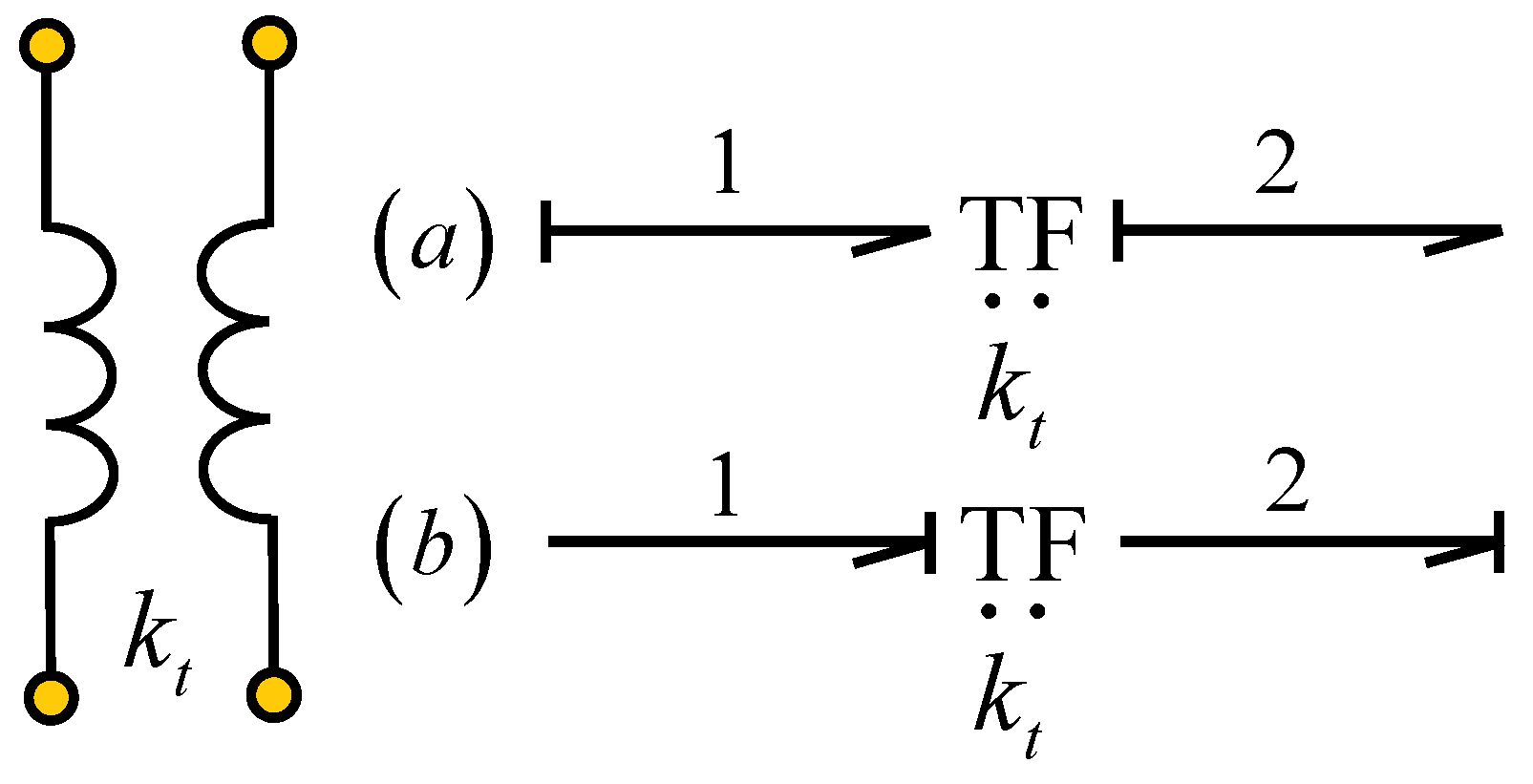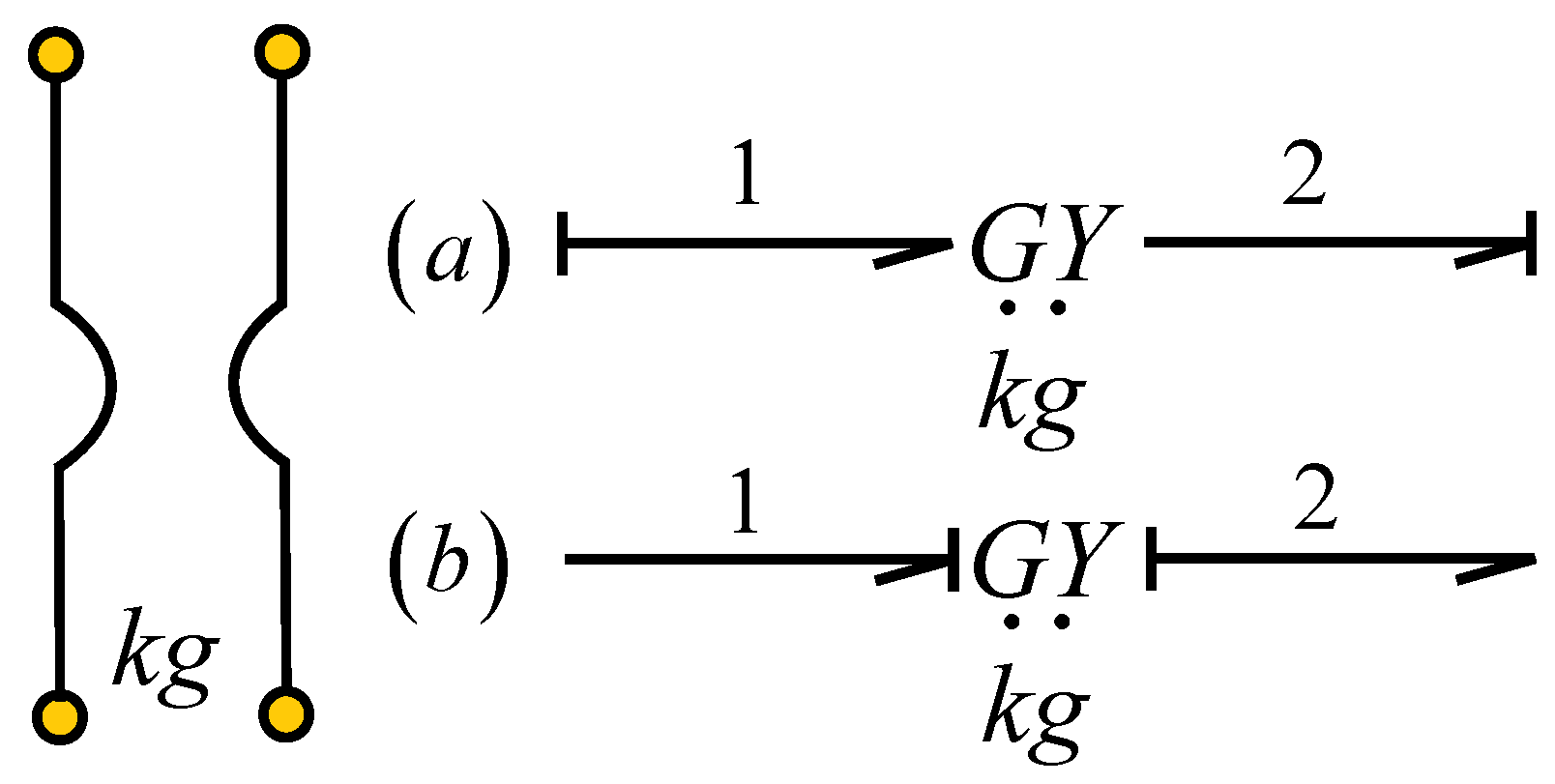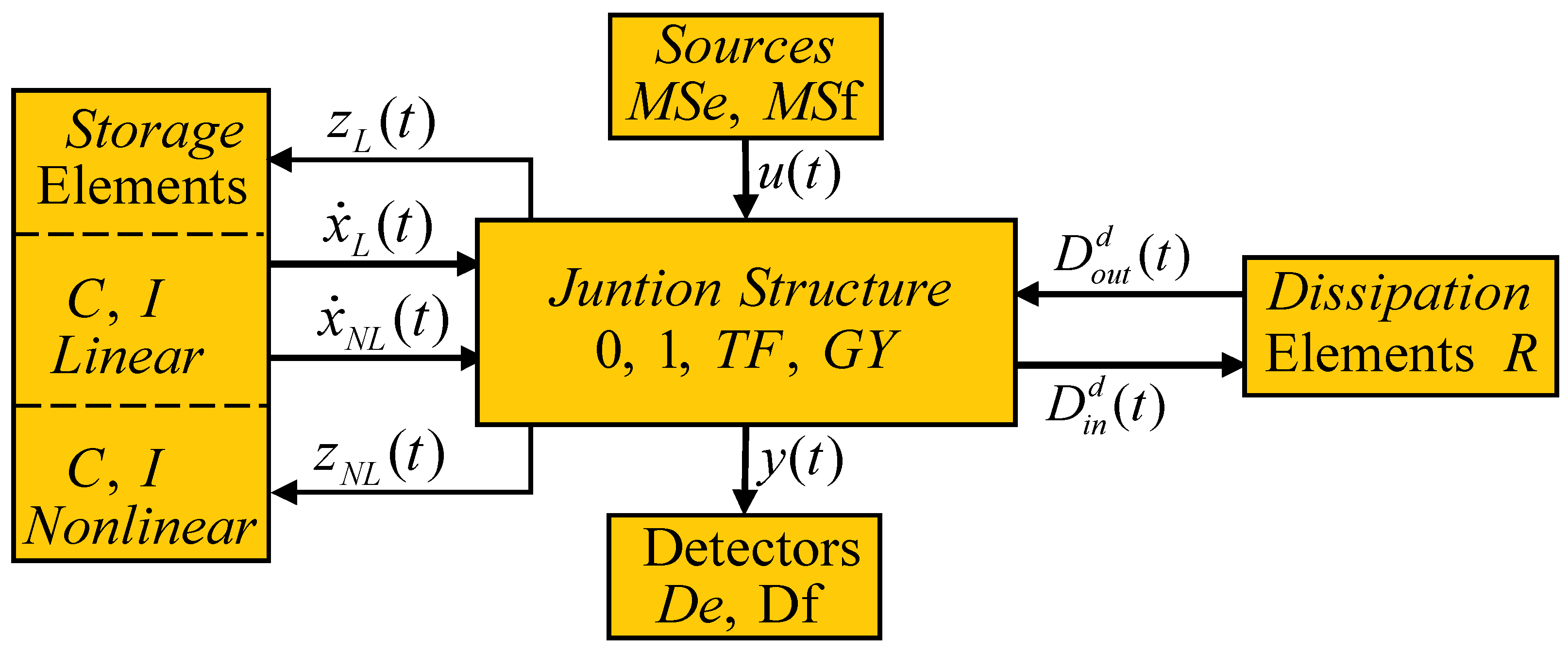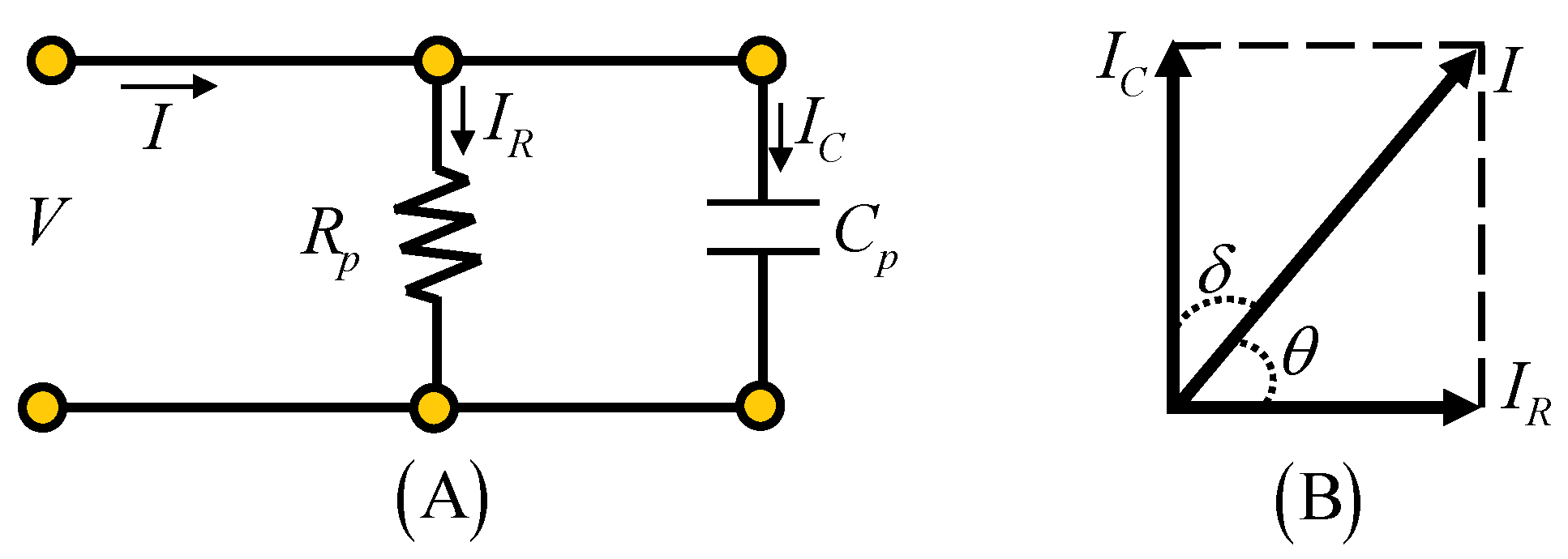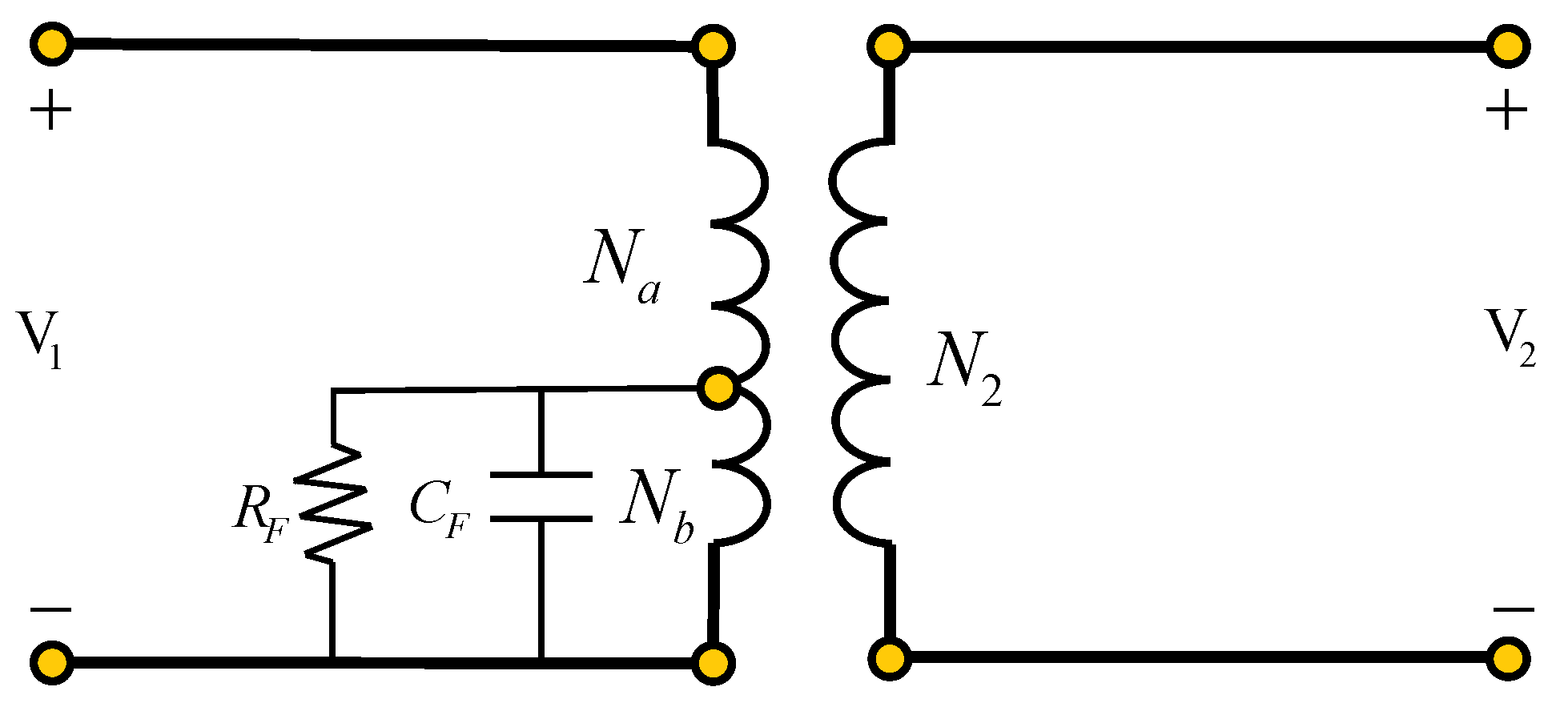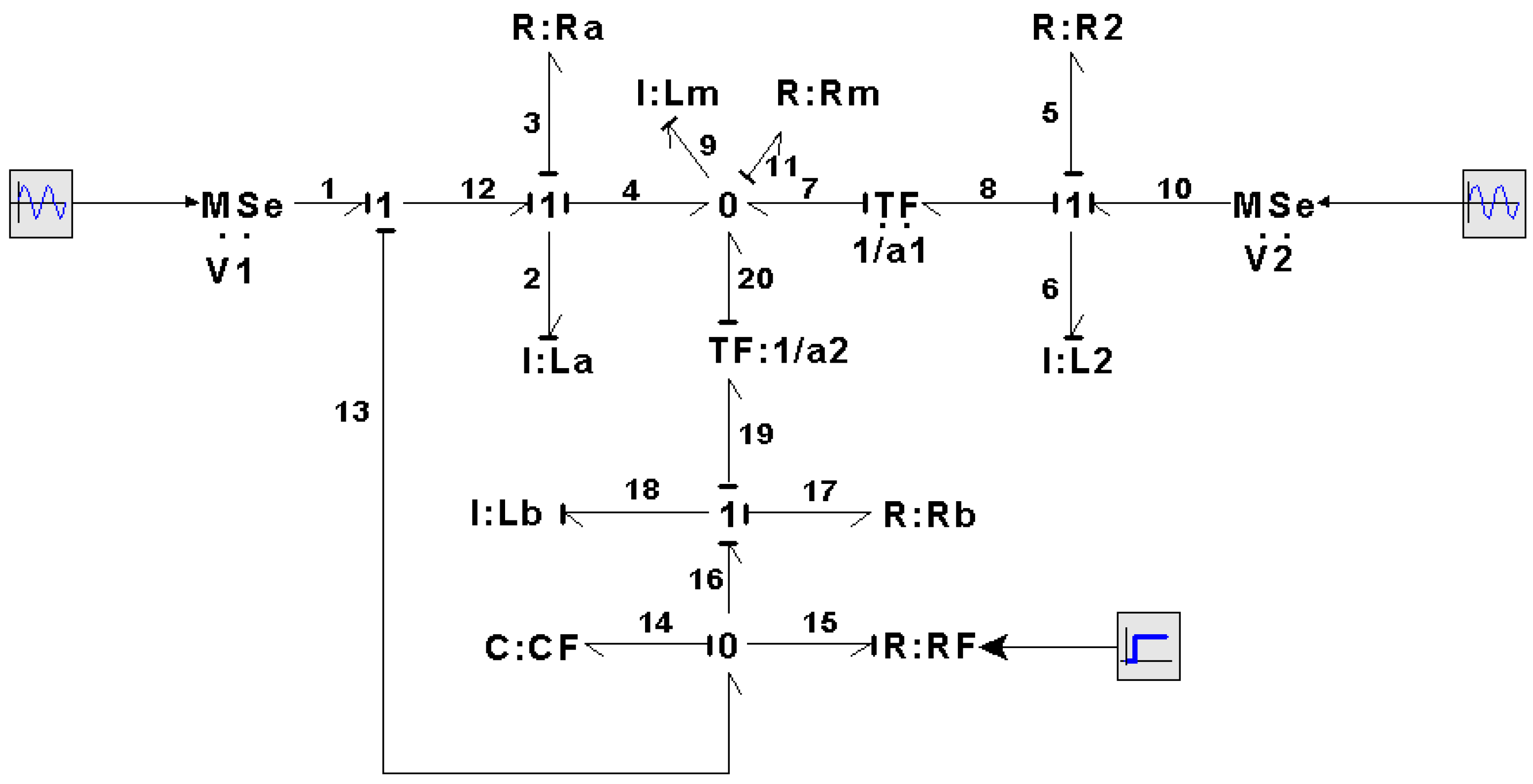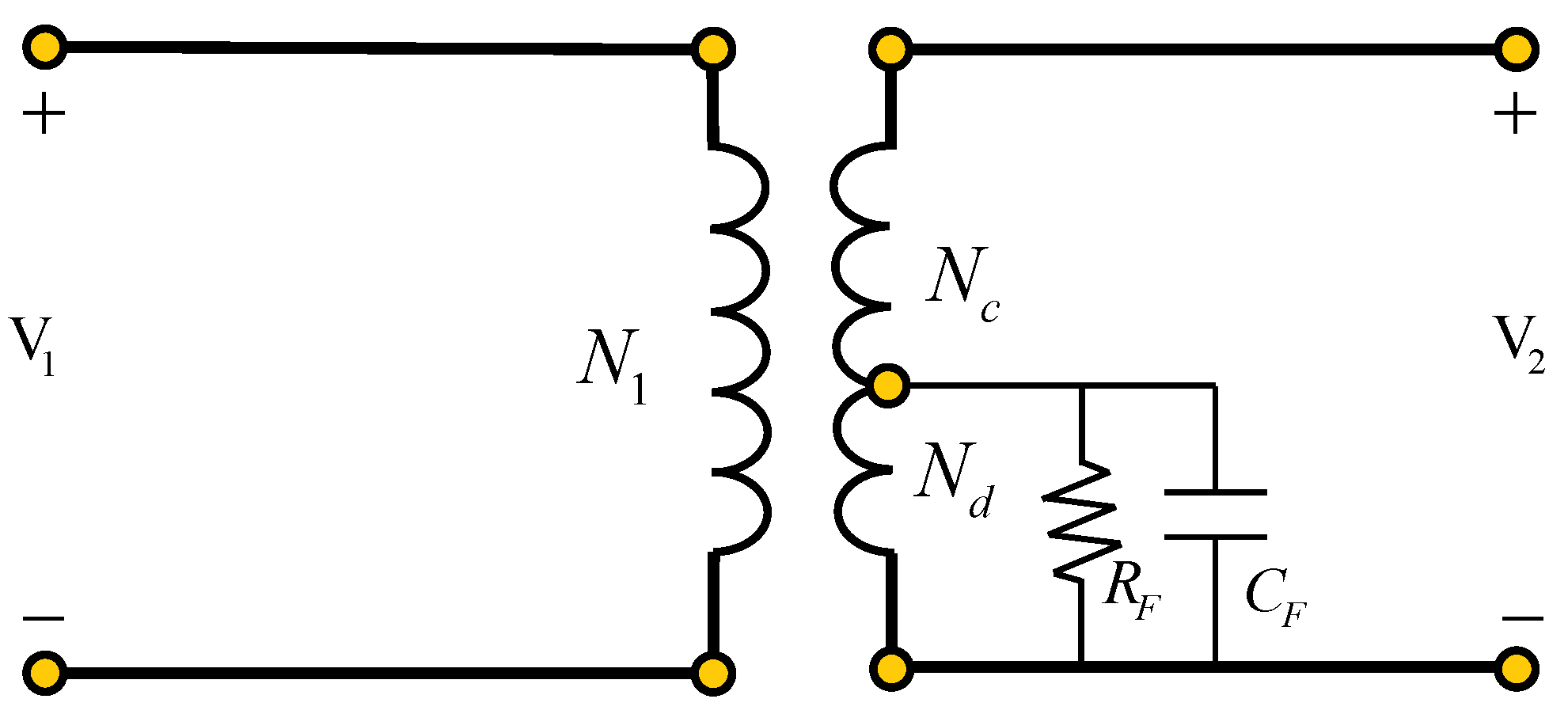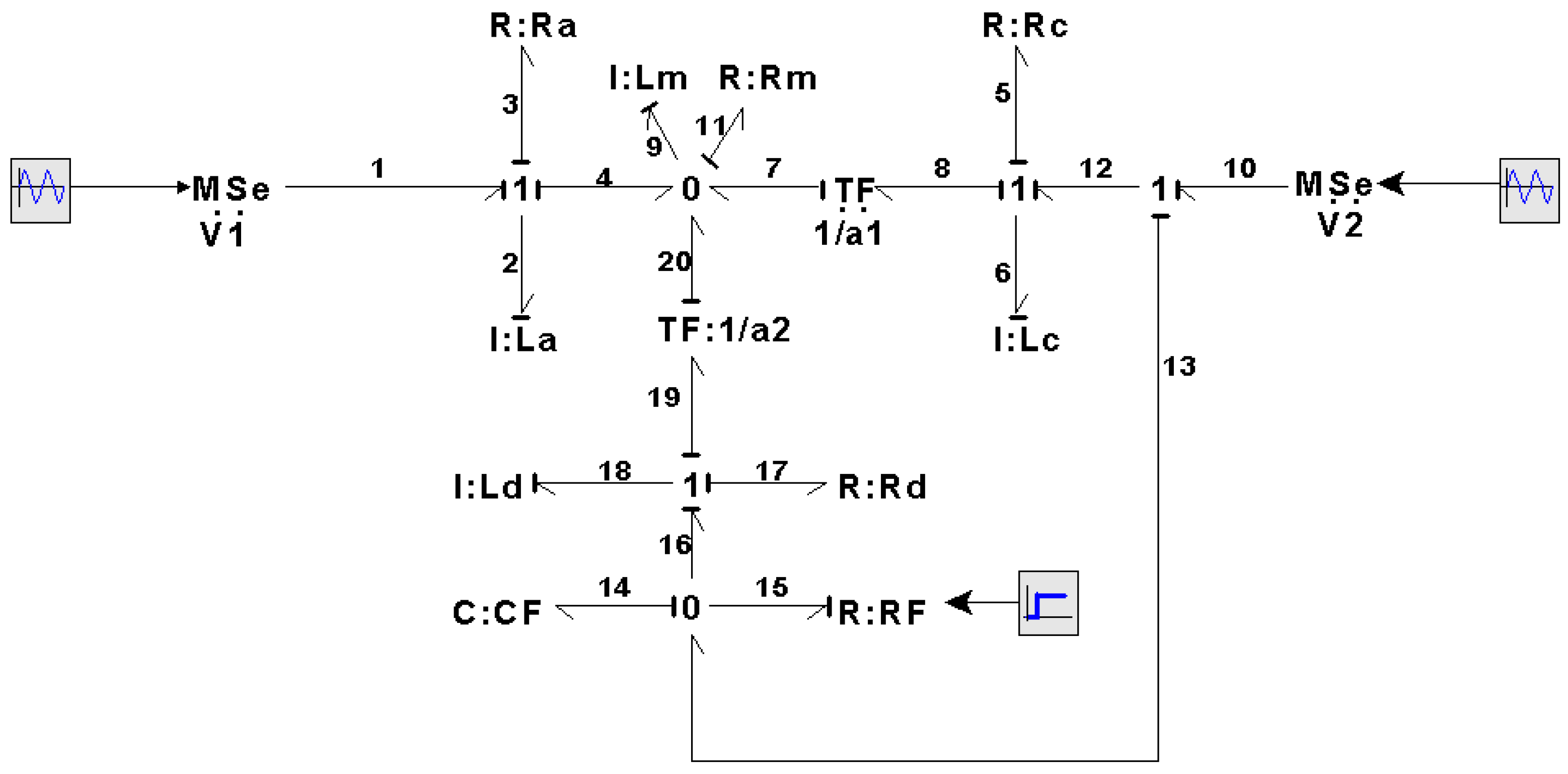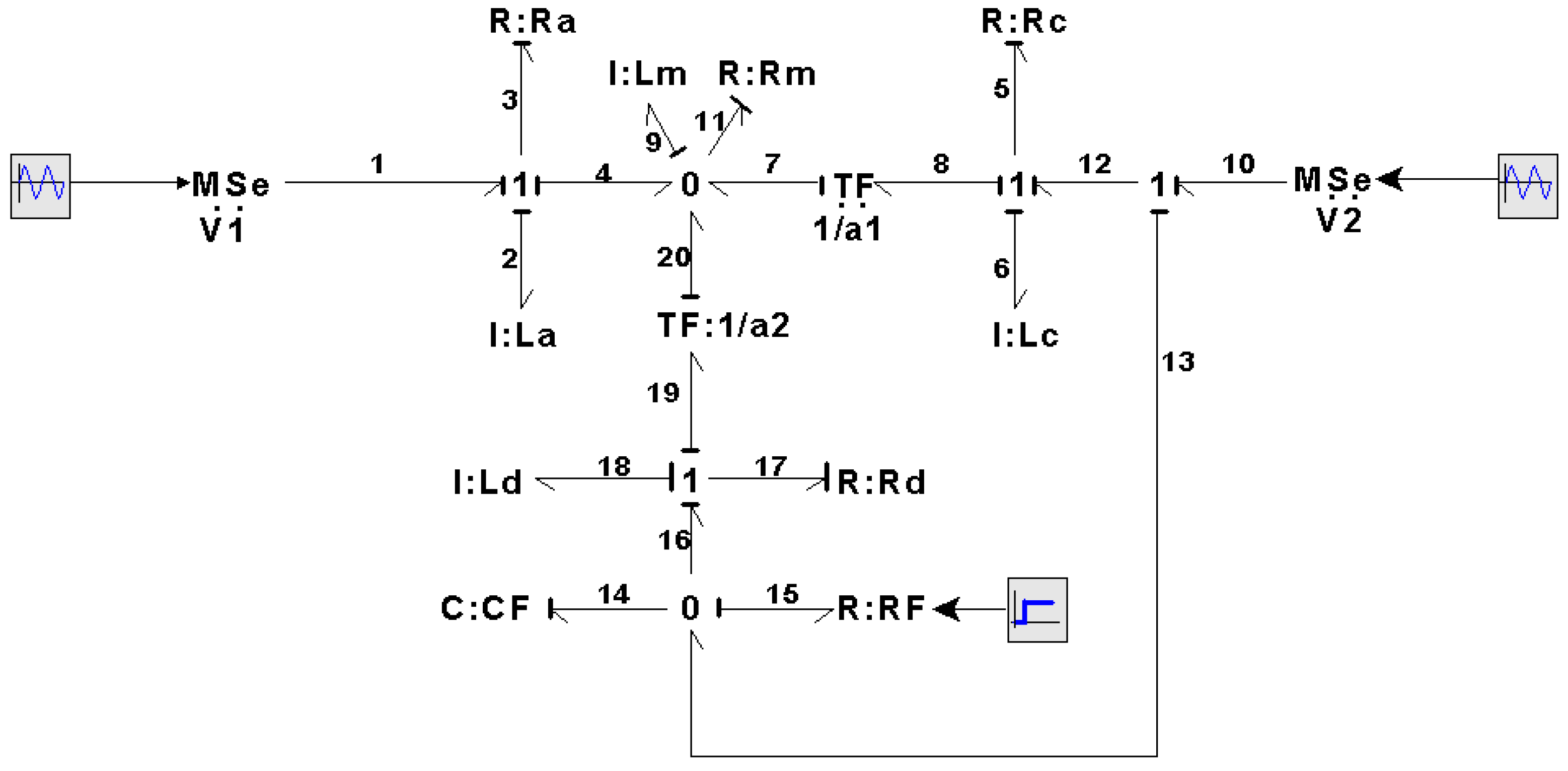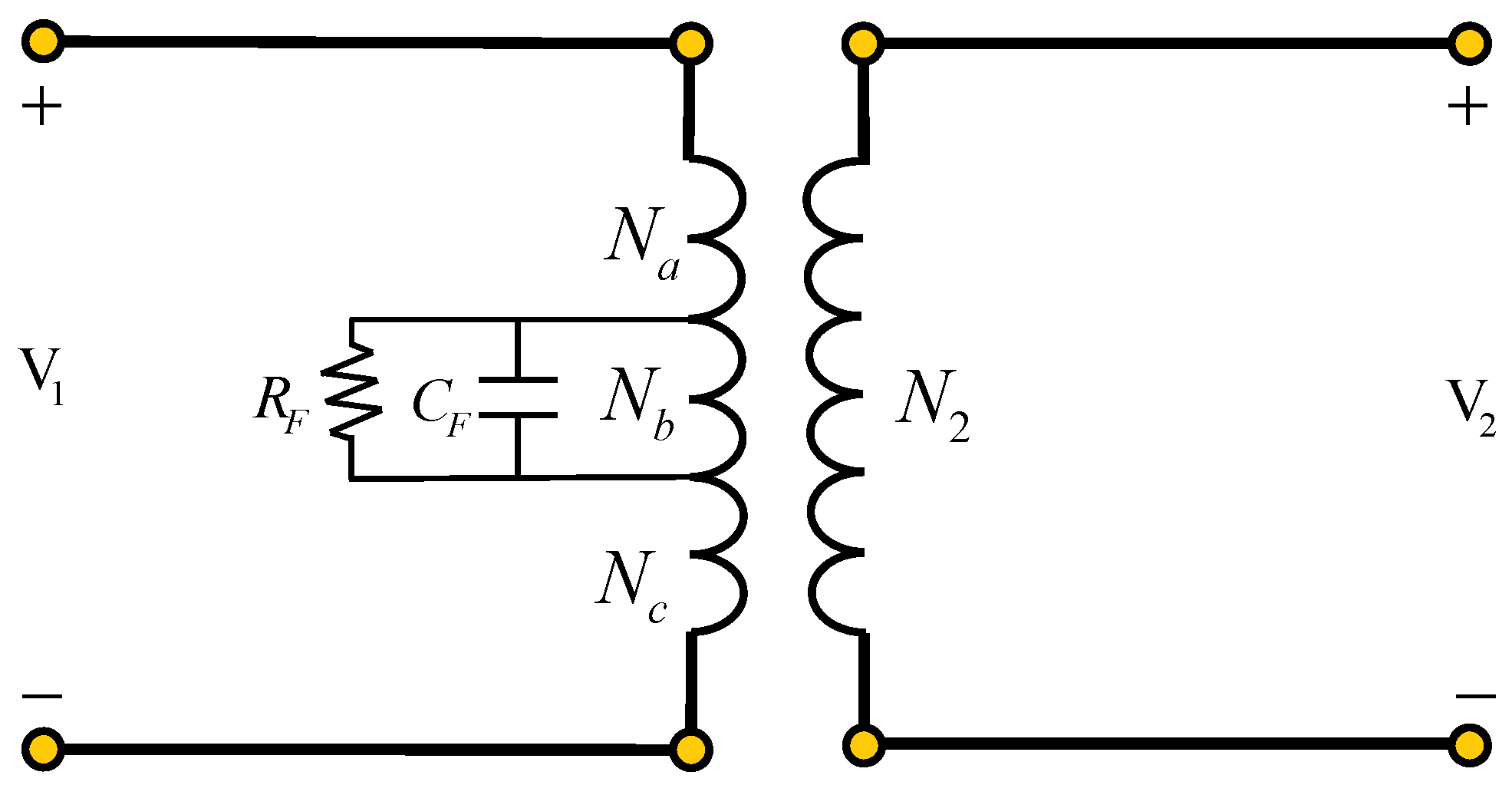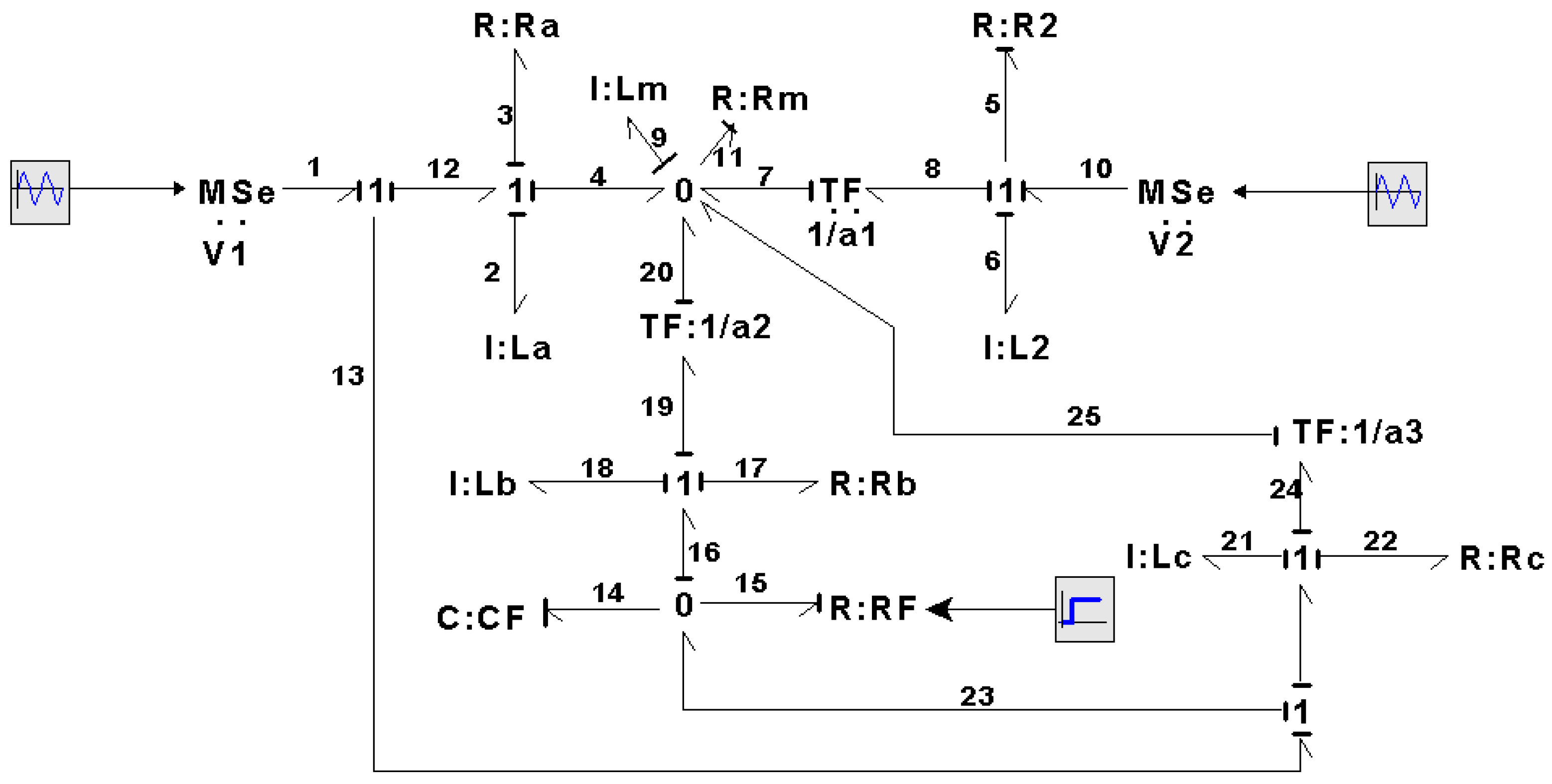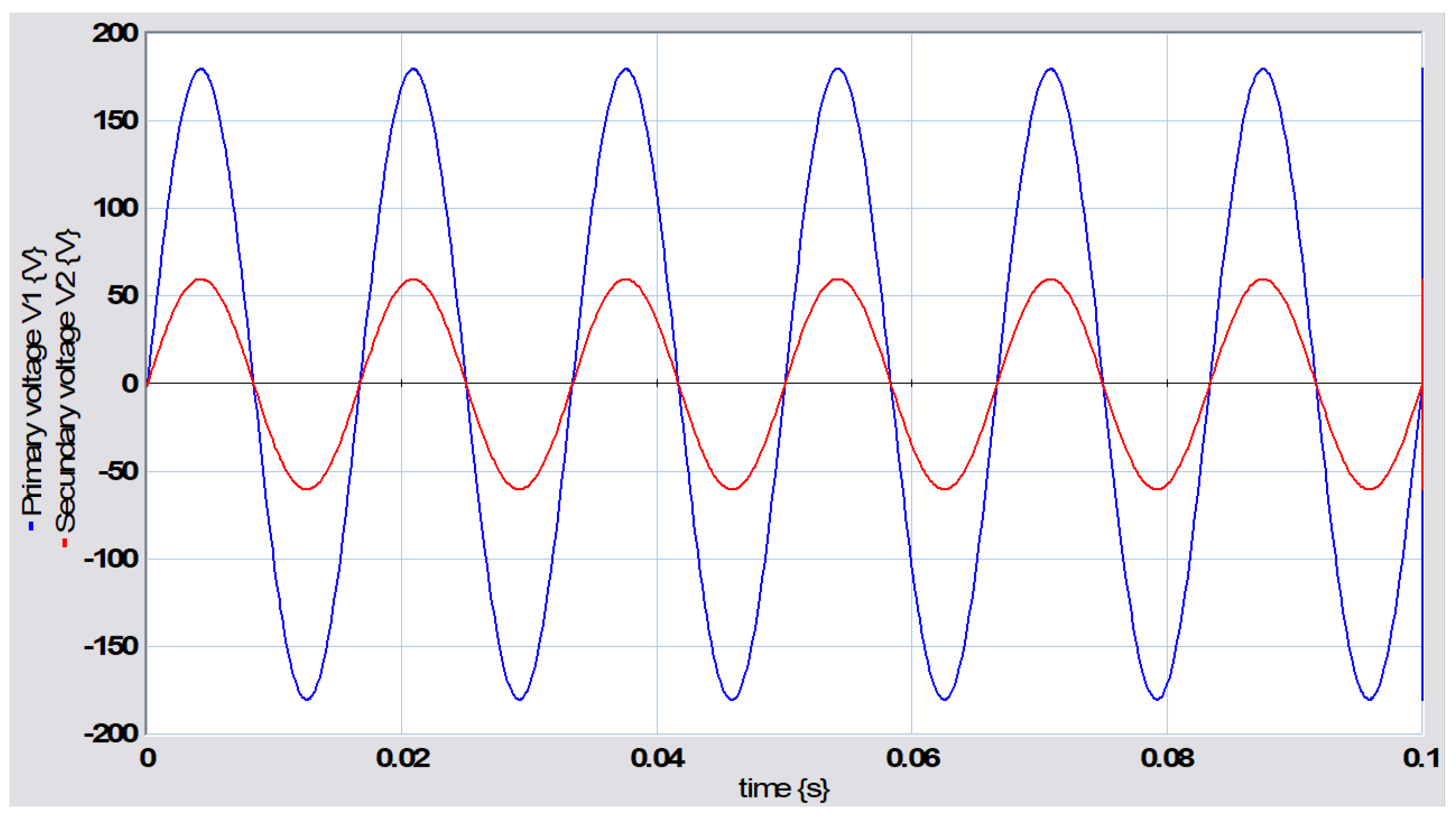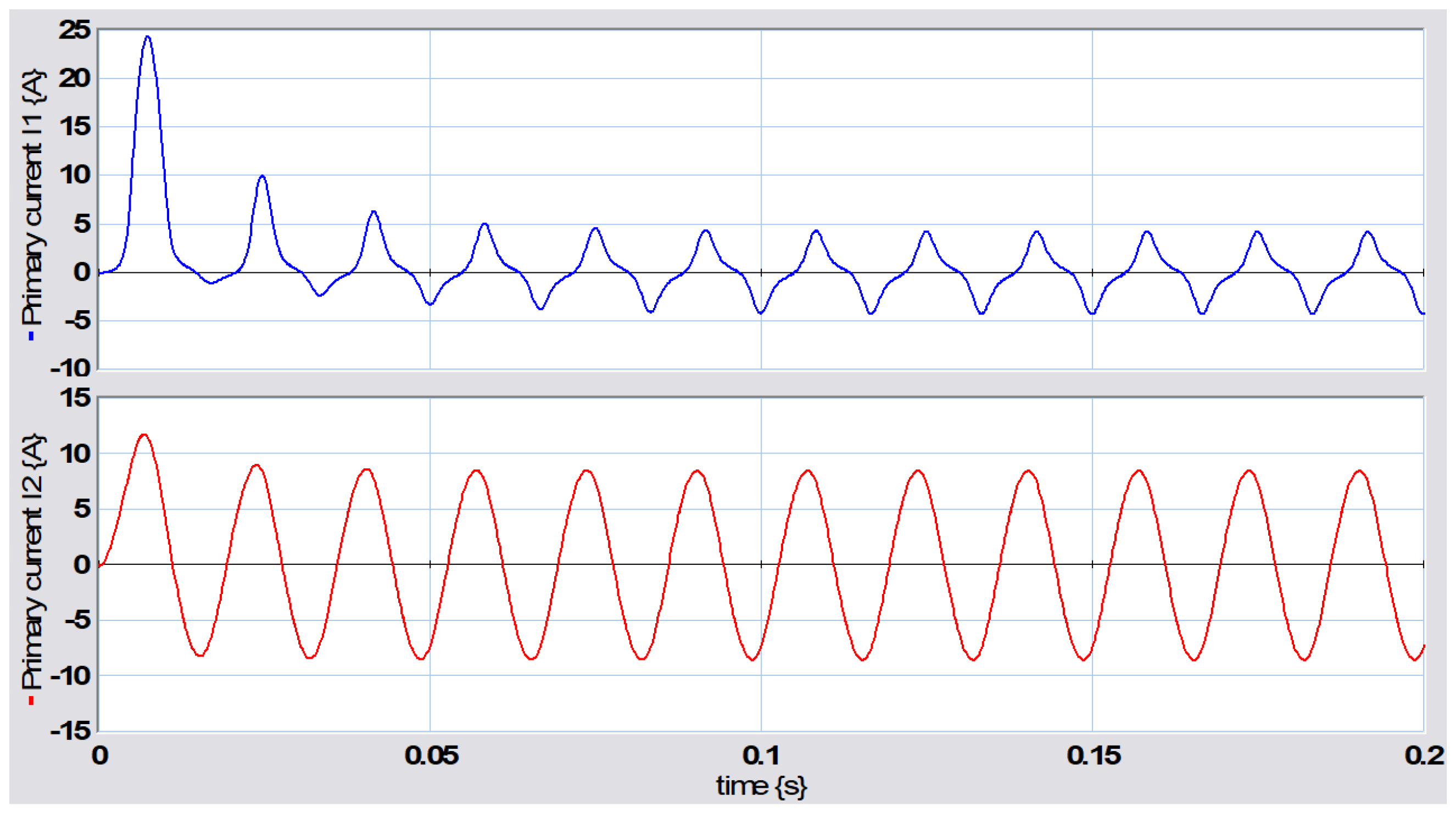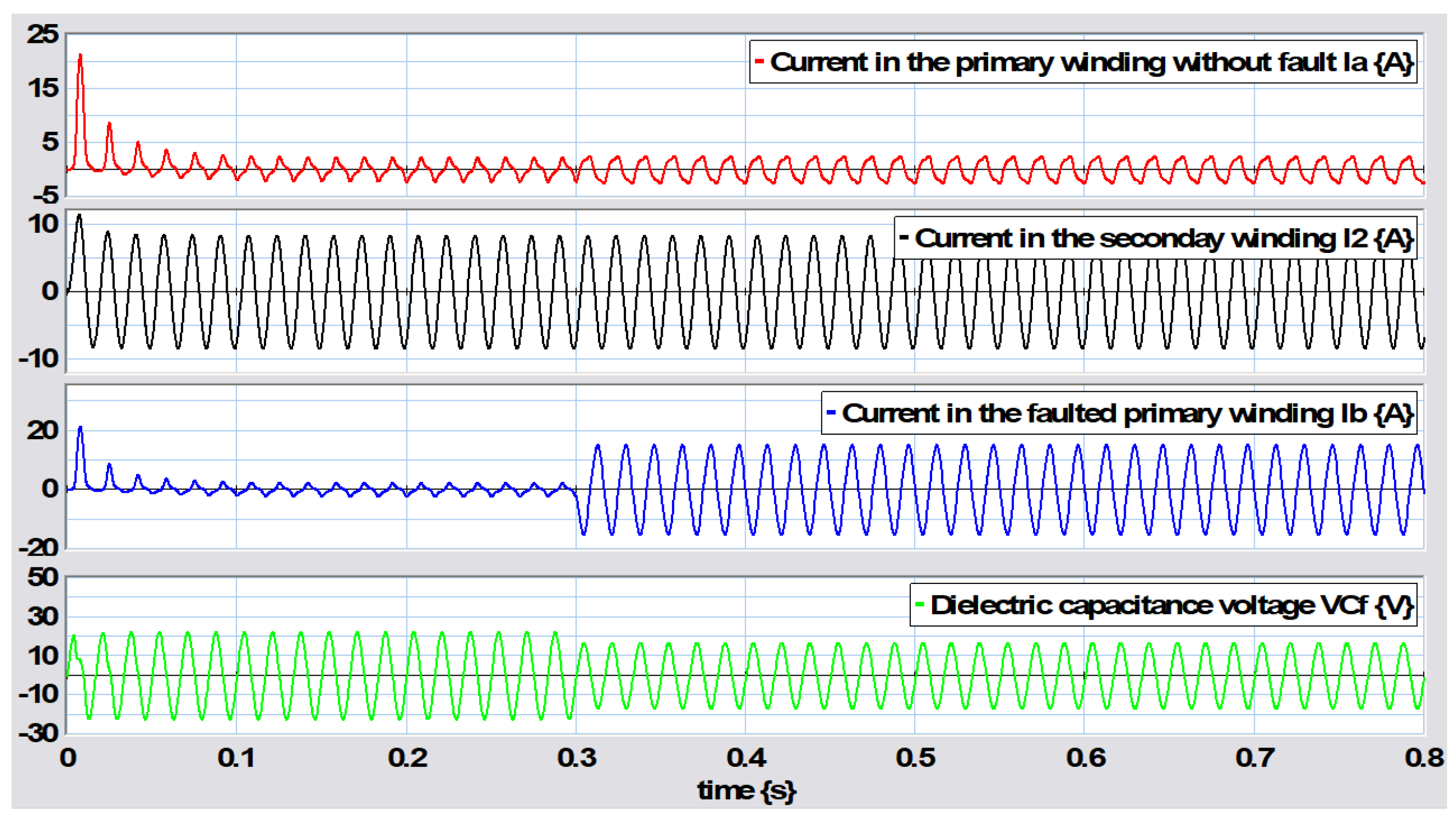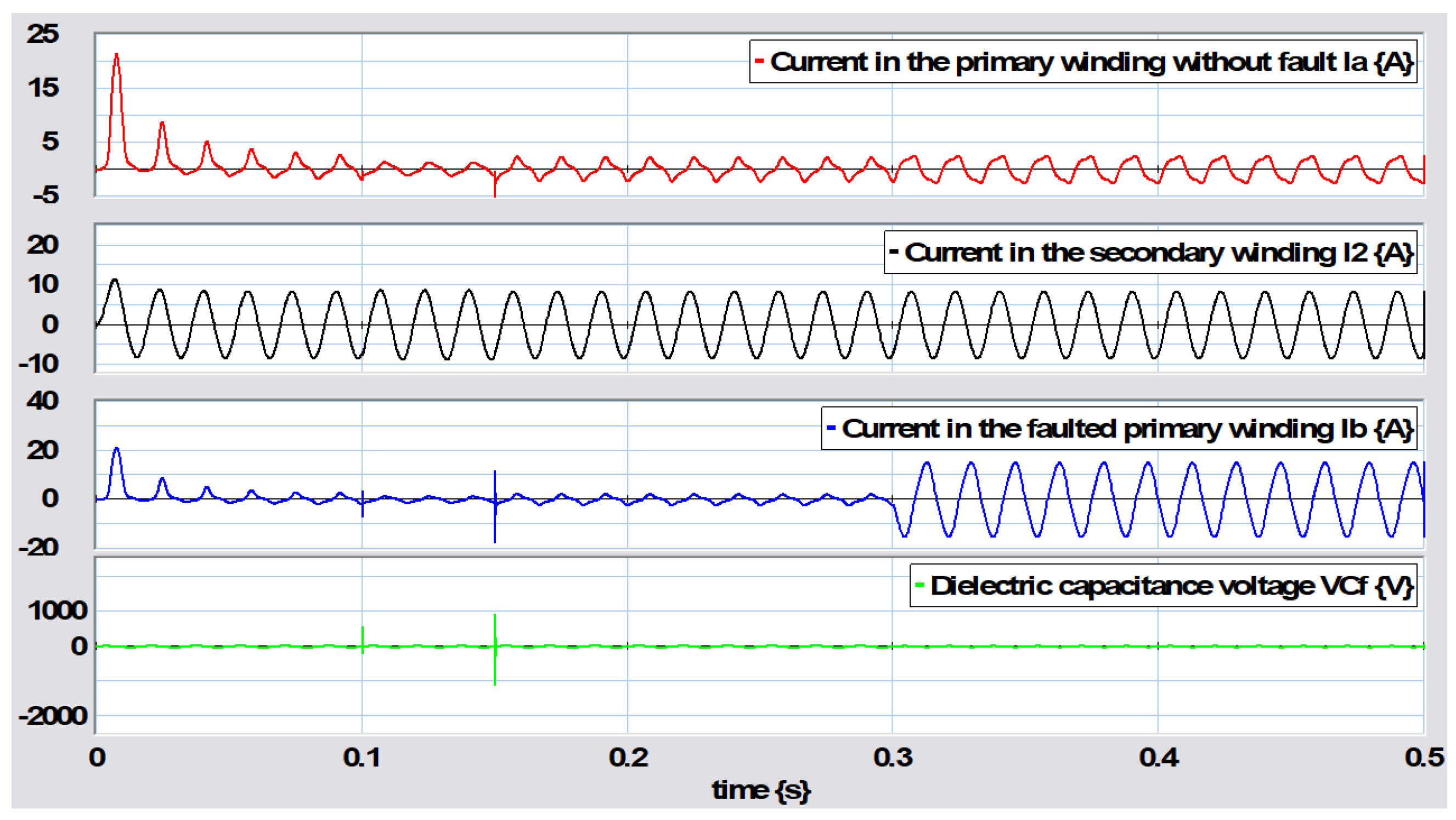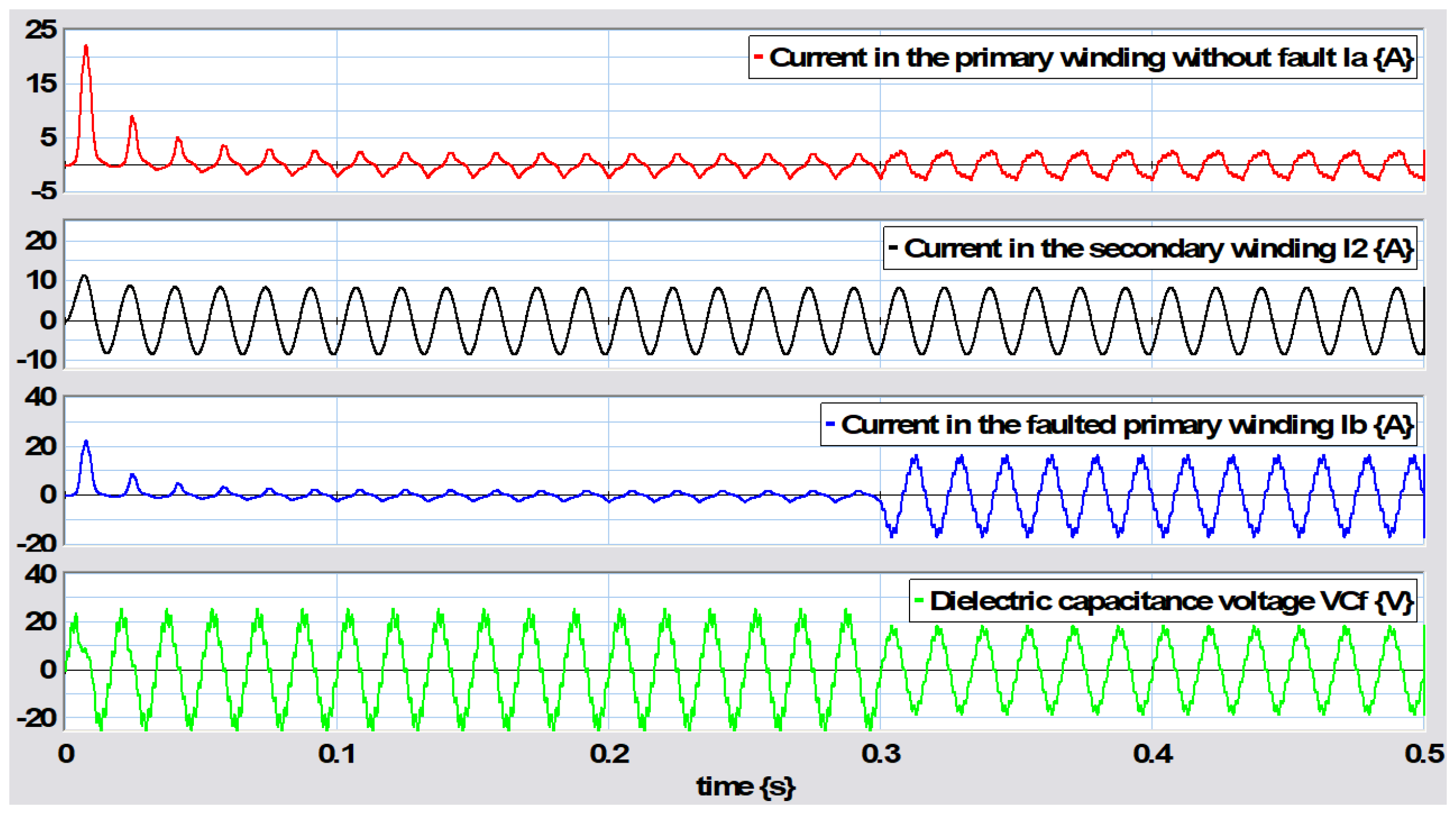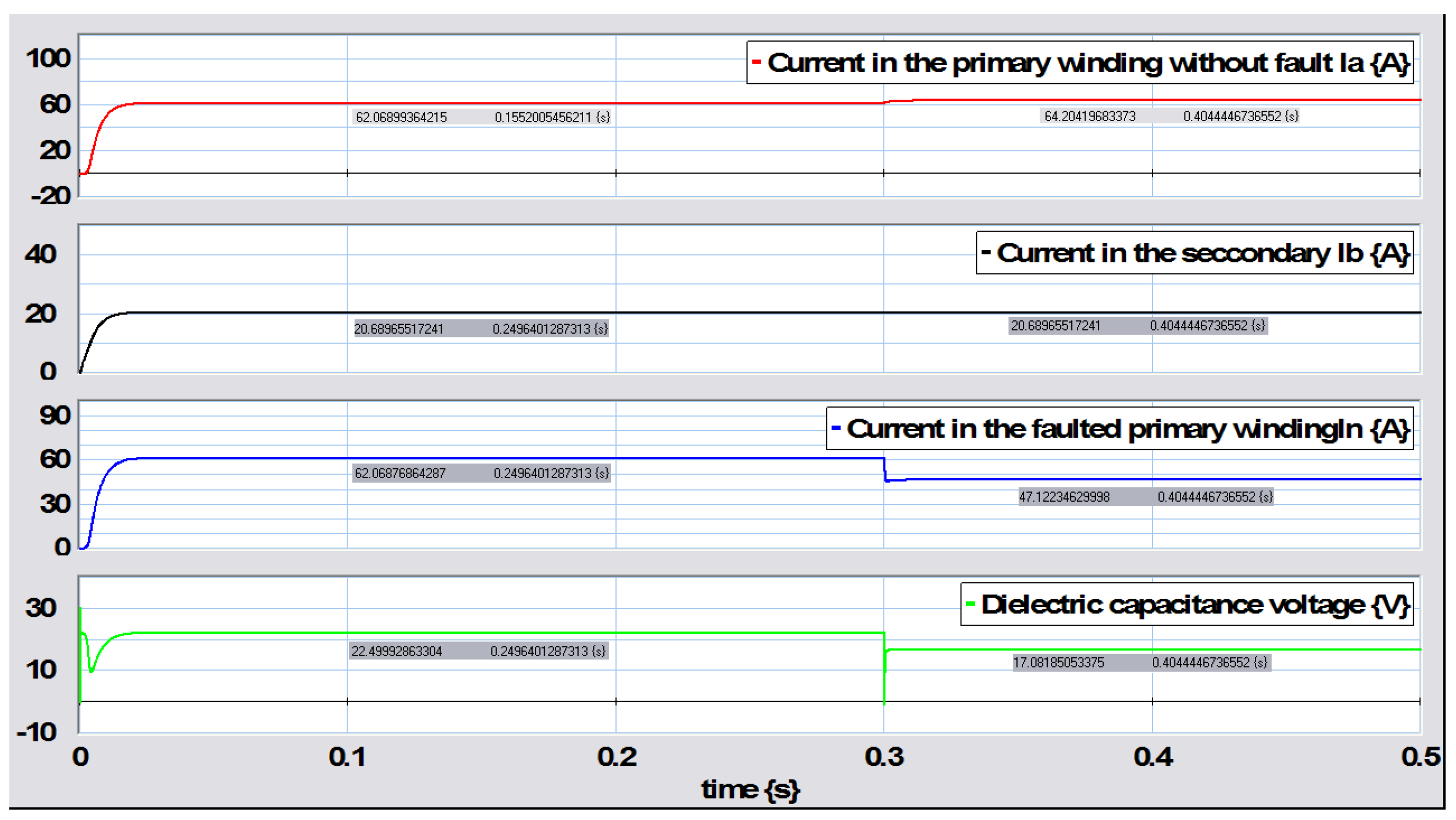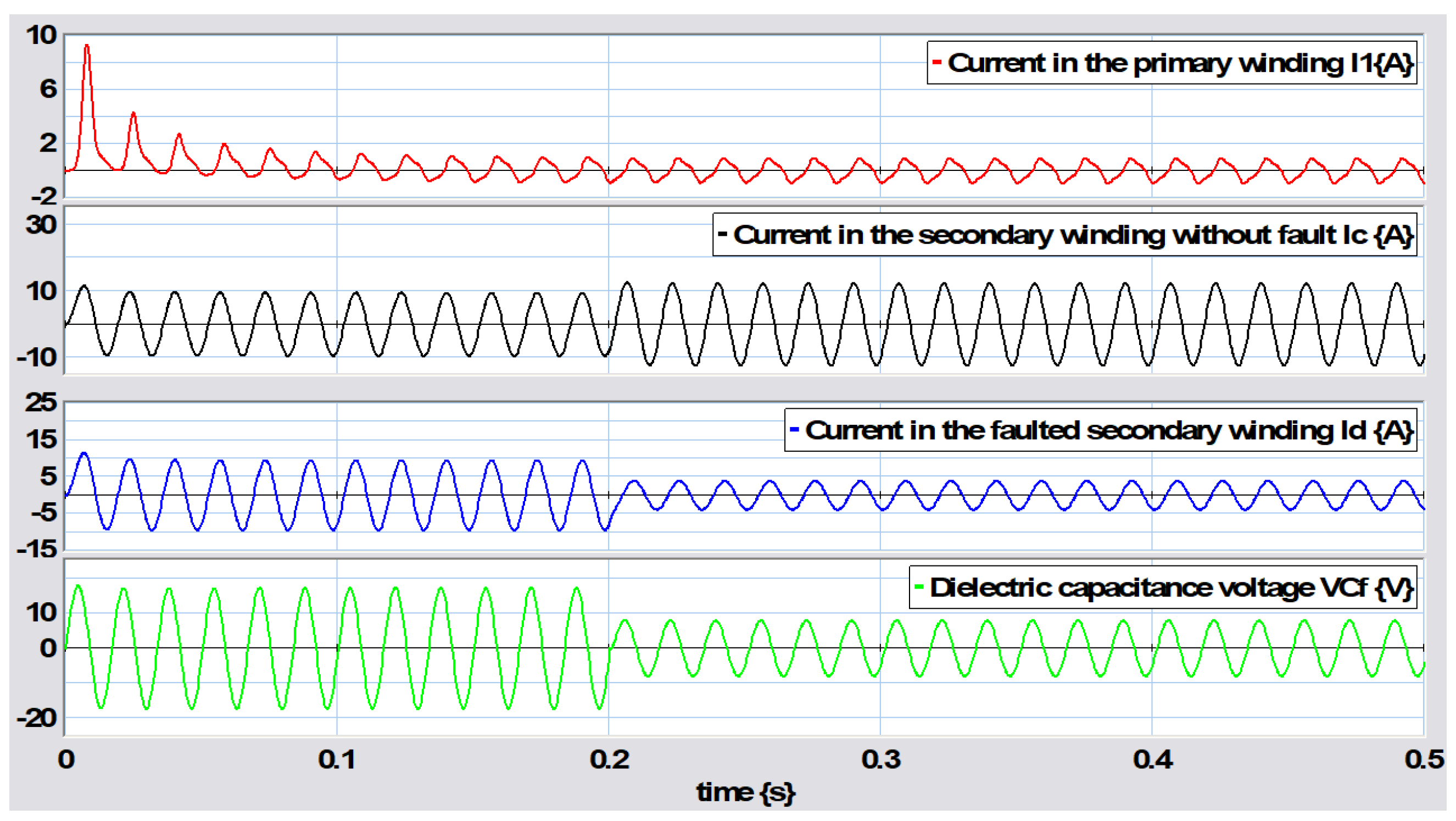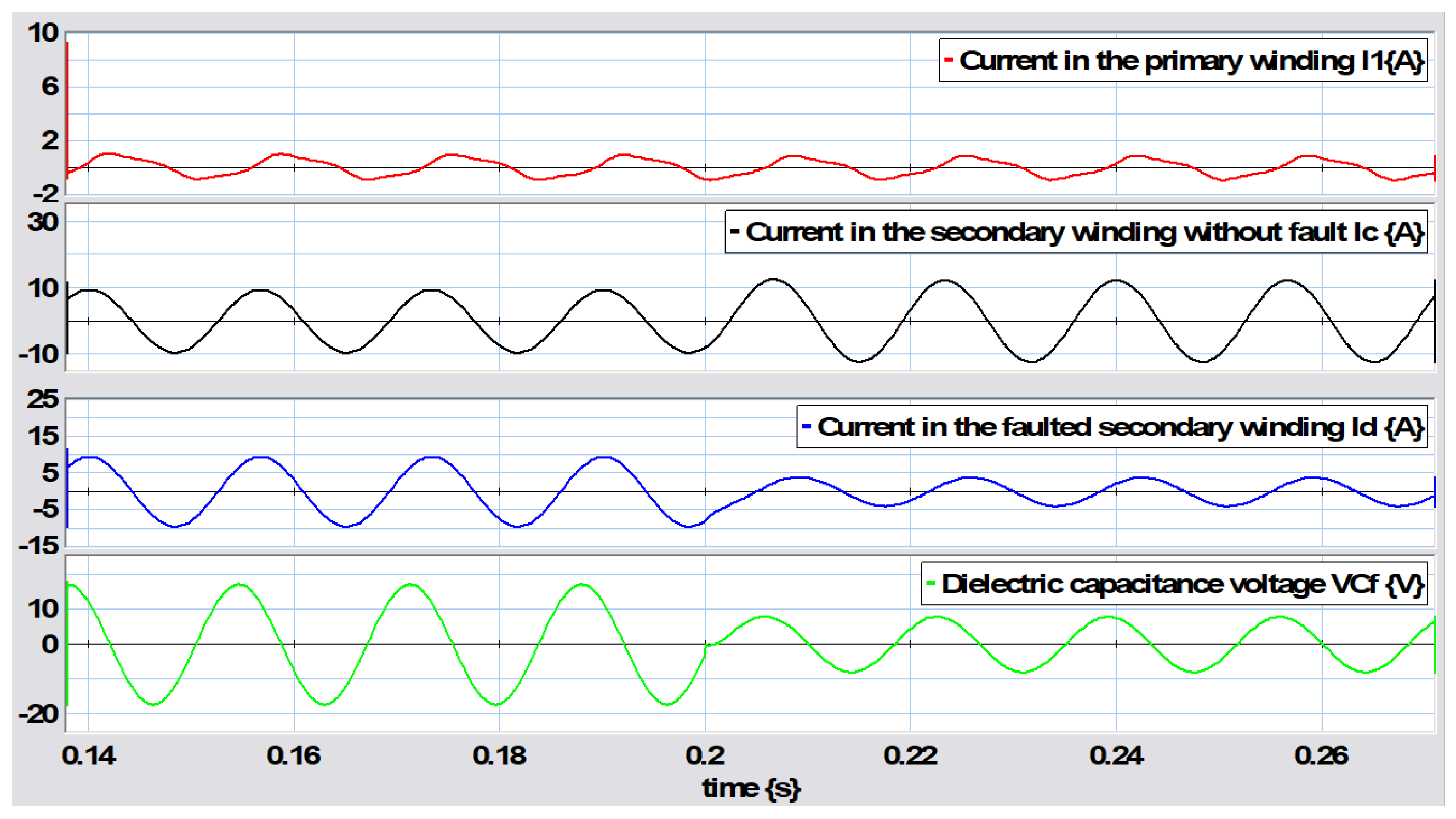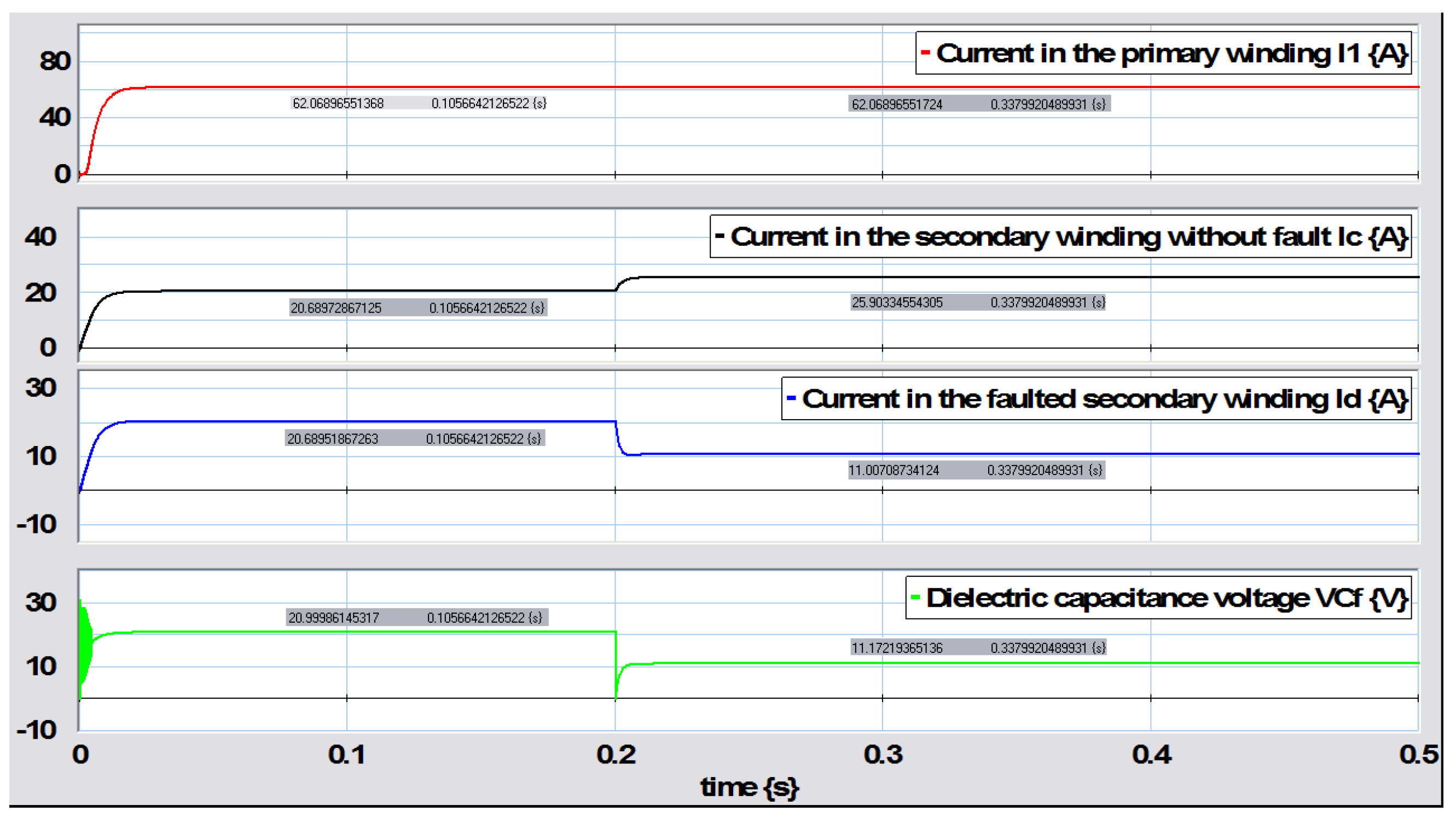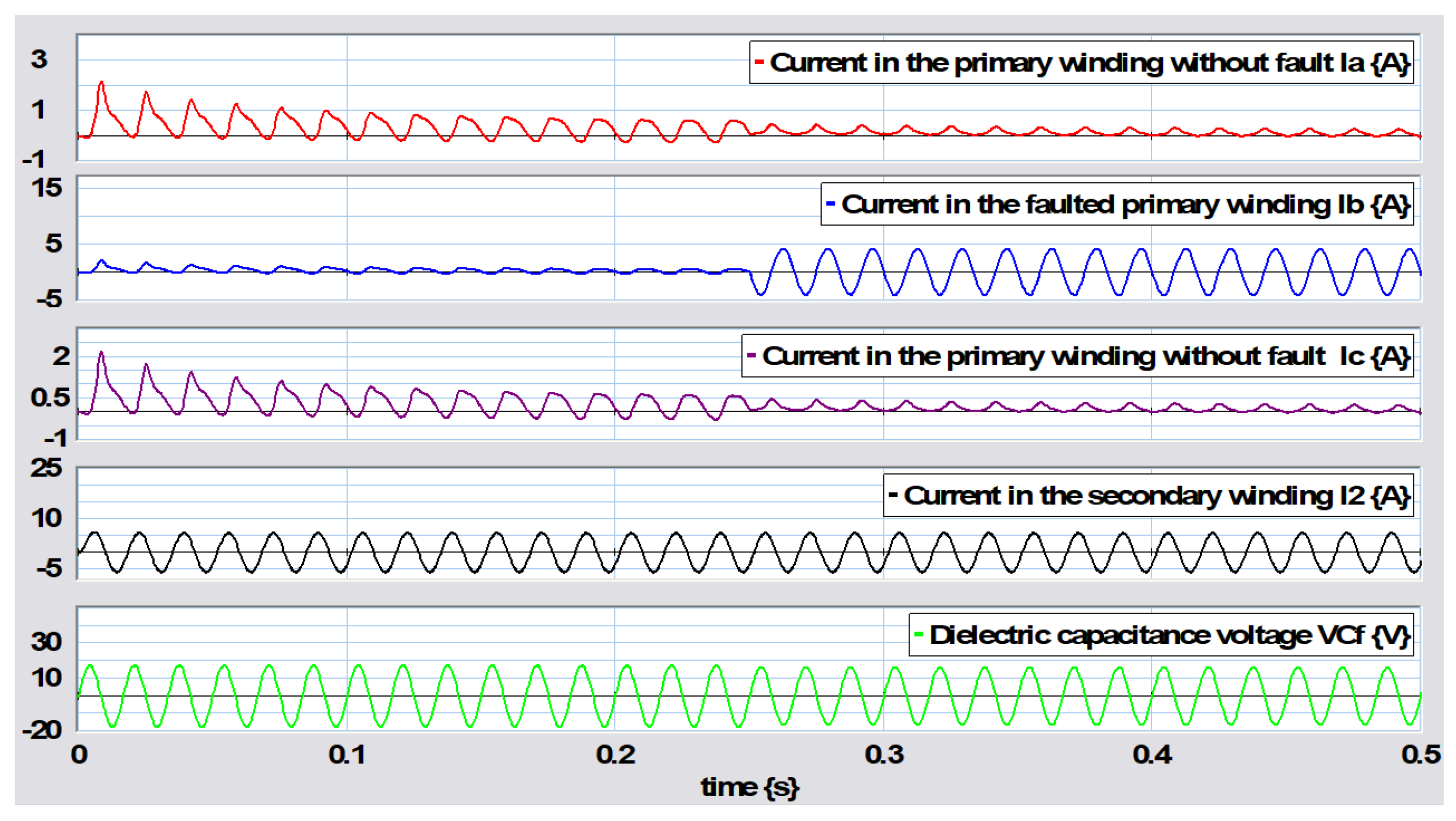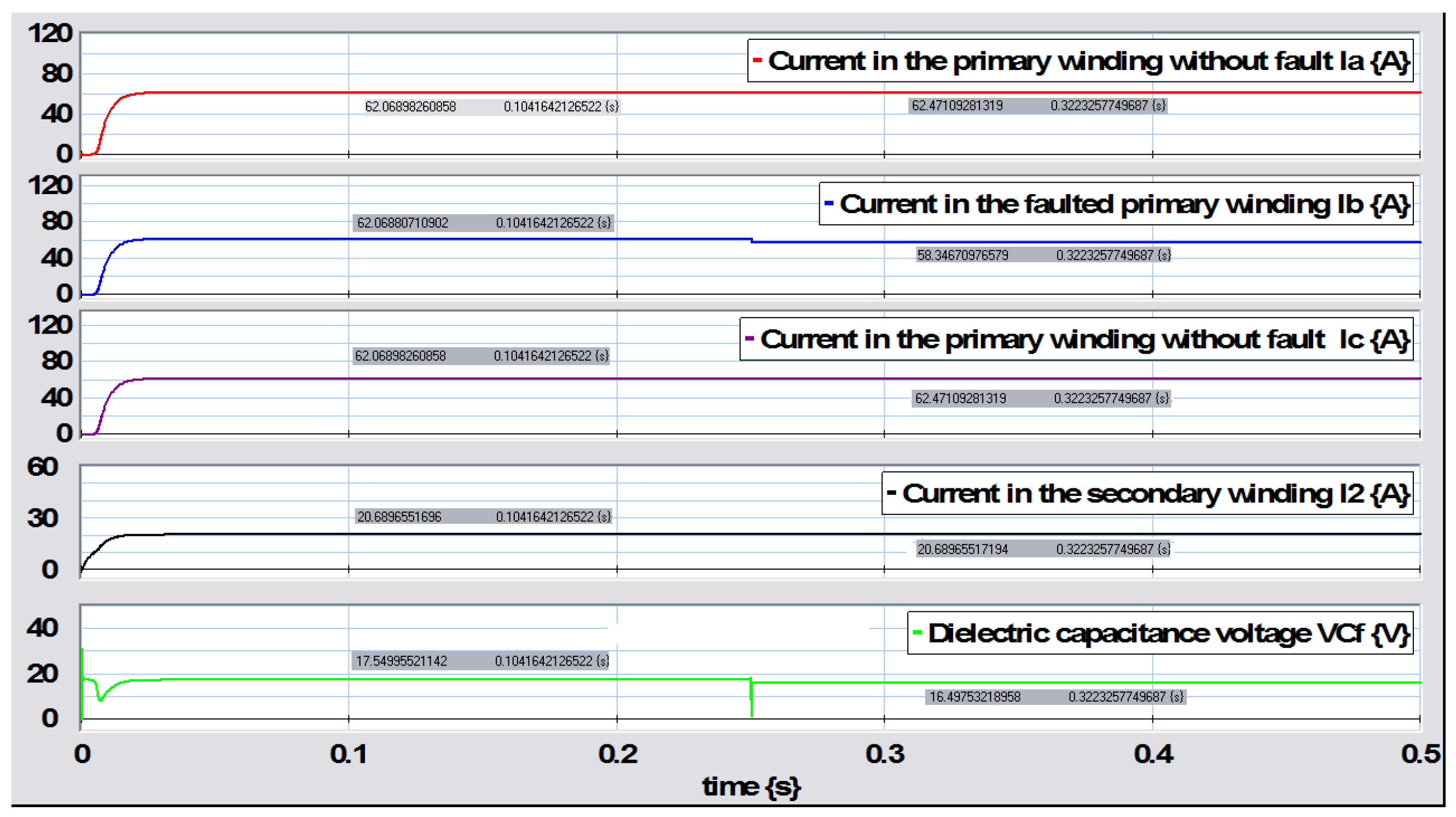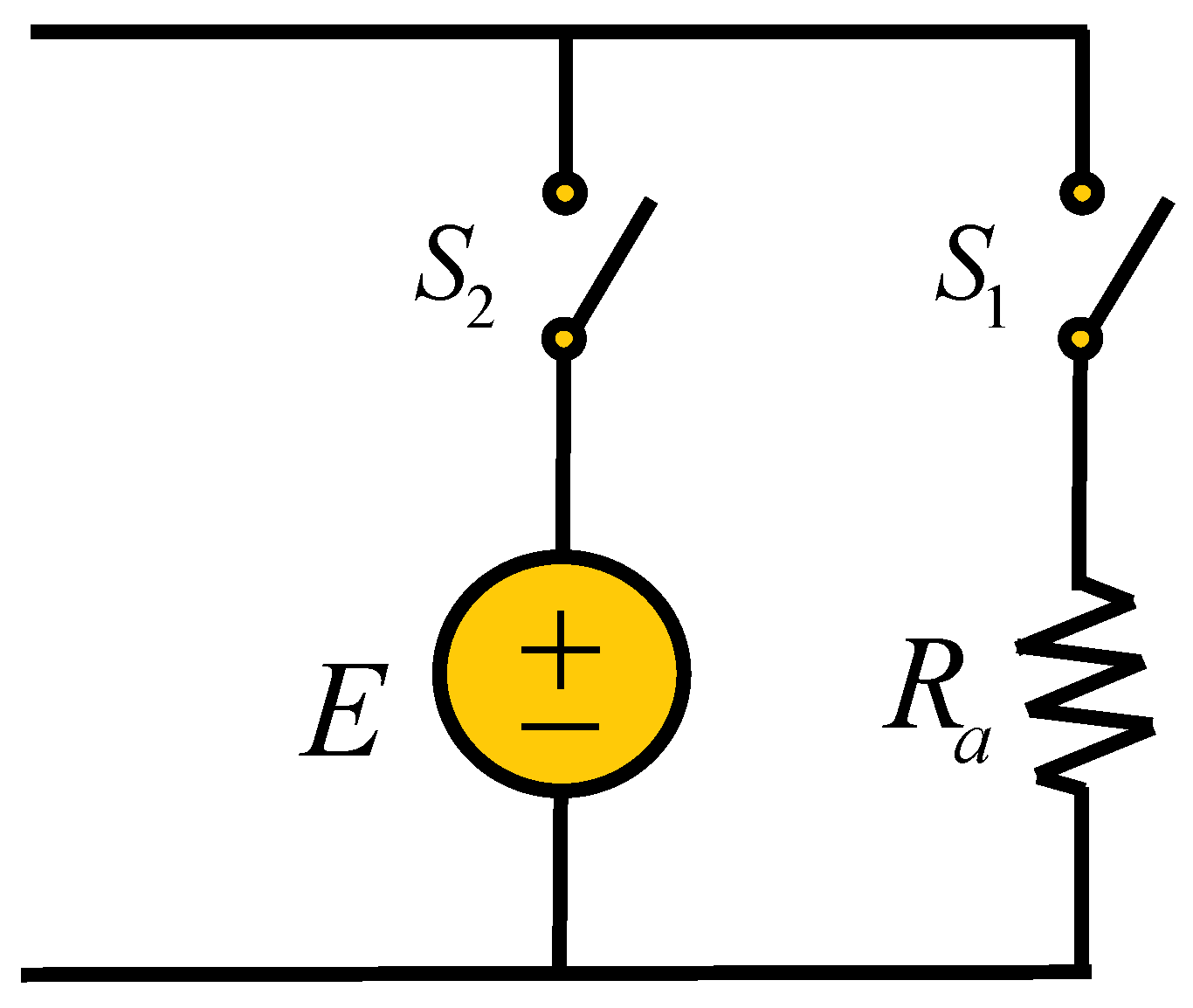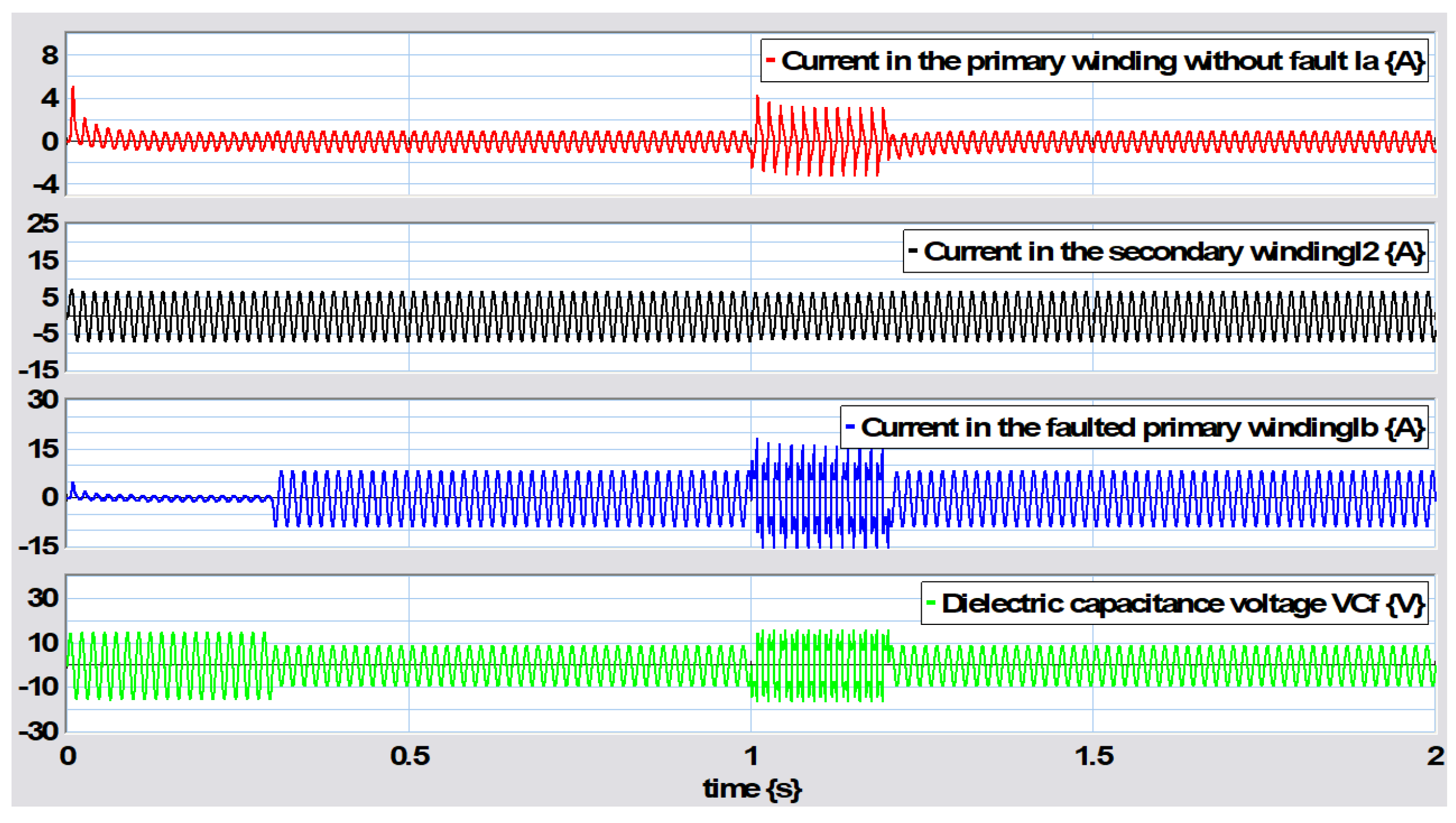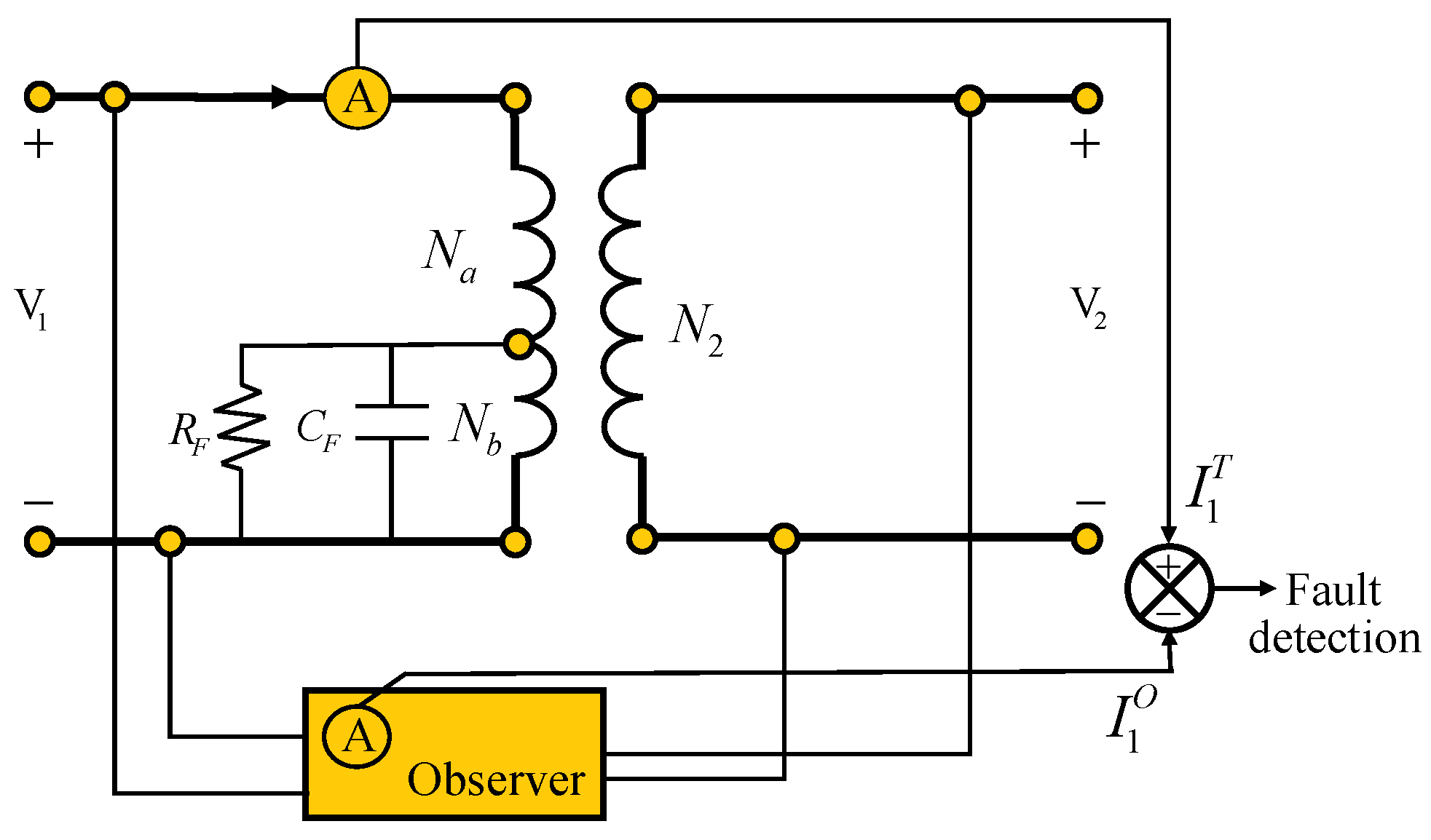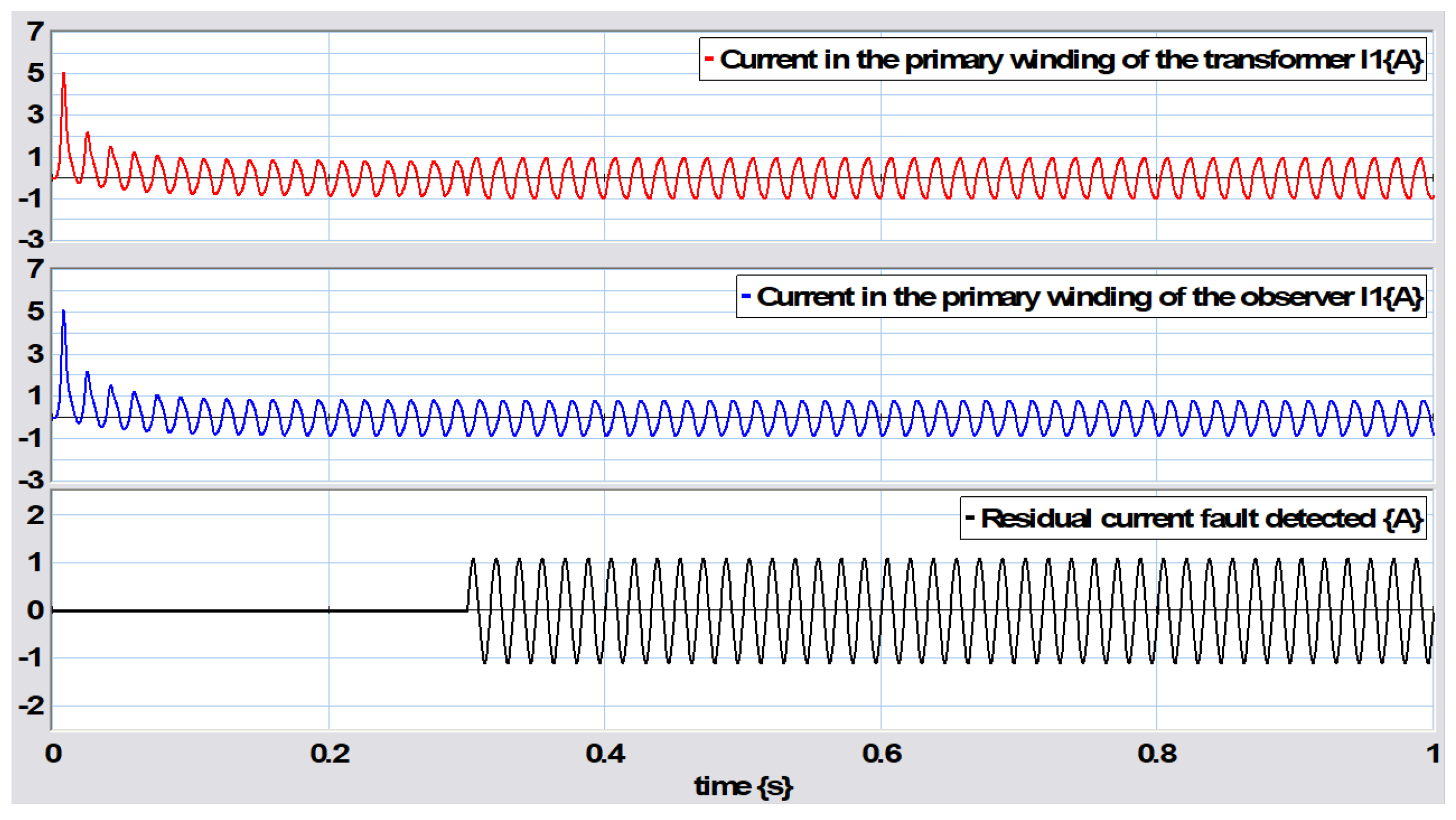1. Introduction
Electrical power transformers are fundamental elements in an electrical power system which link the generation, transmission, and distribution stages of electrical energy under different voltages and currents. However, transformers are susceptible to failure, mainly due to their exposure to adverse environmental conditions. Thus, the modeling of transformers with incipient faults for analysis of their condition has led to interesting and vital studies in the field of electrical engineering.
Some models have been developed for the study of transformers with incipient faults in their windings. One essential model is the transformer with incipient faults proposed in [
1]. Another was presented in [
2]. Subsequently, numerous works have been published on different aspects of transformers with this type of failure, among which the following can be mentioned:
The monitoring of variables of a transformer for the detection and identification of faults has been proposed in [
3]. Predictive models for the detection of incipient failures in transformers were developed in [
4]. The transient response of a winding with an inter-turn discharge was simulated using a finite element model and its mechanical effect on a three-phase transformer was analyzed in [
5]. A diagnostic model for incipient transformer faults using artificial neural networks was developed in [
6]. A method for modeling incipient faults in single-phase transformers that is compatible with the ATP software has been presented in [
7]. A computational and experimental study of magnetic and electrical variables for the detection of incipient faults in transformers was reported in [
8]. Computational models for the simulation of incipient transformer failures have been developed in [
9].
A scalable design for the simulation of winding failures in three-phase transformers using numerical statistical methods was investigated in [
10]. A new S-transform (ST) for the protection of transformers with incipient faults was proposed in [
11]. A learning system which can be applied for the recognition of internal faults in miniature transformers was presented in [
12]. The injection current to a power transformer required to assess an internal fault and the behavior of the differential relay was analyzed in [
13]. Fault detection in power transformers using fuzzy logic and neural networks has been discussed in [
14]. A multi-layer artificial neural network to identify incipient faults in transformers was proposed in [
15]. The diagnosis of incipient faults in power transformers using fuzzy logic was proposed in [
16].
Online monitoring of the instantaneous exciting current space phasor in transformers allows for the detection of inter-turn faults, as proposed in [
17]. An intelligent expert system for the diagnosis of faults in power transformers was applied in [
18]. A review and analysis (including challenges and future directions) regarding the detection of incipient failures in power distribution networks was developed in [
19]. Vibration frequency analysis for the detection of inter-turn faults in transformers as a novel approach was proposed in [
20]. The modeling and simulation of a three-phase transformer in Matlab for monitoring purposes was developed in [
21]. The modeling of three-phase transformers under internal fault conditions and the behavior of the
magnetizing current were analyzed in [
22]. The use of machine learning approaches to interpret data on incipient failures in power transformers has been discussed in [
23]. The application of the hyperbolic S-transform to detect incipient faults in transformers was proposed in [
24].
The bond graph methodology was introduced by Paynter in 1961. Subsequently, researchers such as Karnopp, Rosenberg, Thoma, Brown, and Breeveld have published numerous advances in papers and books that comprise the state of the art regarding the modeling and application of bond graphs. A bond graph determines the formal and unified procedures in the modeling of dynamic physical systems. One of the main characteristics of a bond graph is the ability to analyze the exchange of power between its elements. This unified character allows for the modeling of systems comprising several energy domains (electrical, mechanical, hydraulic, magnetic, thermal). Likewise, the structural properties of systems—such as their stability, observability, controllability, and steady-states—can be derived almost directly from systems modeled as bond graphs. In addition, bond graphs have been extended for control design activities. To date, bond graph modeling has been widely used to obtain new procedures for the structural analysis of systems [
25], model reduction [
26,
27], as well as the development of system modeling software [
28]. Systems modeled using bond graphs can be linear or non-linear, and time-variant or time-invariant. Essential references on modeling with and the properties of bond graphs include [
29,
30,
31]. However, recent advances in bond graph theory comprise various directions, as detailed below.
A non-linear transformer model using a bond graph approach to understand the energy exchanges in a traction chain and perform parameter identification was studied in [
32]. A method for converting electrical circuits to their bond graph equivalent for modeling and simulation in SPICE was proposed in [
33]. The use of bond graphs as tools in control theory for mechatronics students and for the design of a PID controller was discussed in [
34]. A bond graph model representing a virtual model of the mechanical and hydraulic interconnections in Rough-Terrain Variable Reach Trucks was presented in [
35]. The fault diagnosis of a three-phase induction motor using a bond graph and a time causal graph was proposed in [
36]. A dynamic model of an isolator was obtained from the associated bond graph, and the energy transfer characteristics were found in [
37].
The use of a bond graph representing a thermal system (incubator) to localize an industrial system according to analytical redundant relationships and applying linear fractional transformations was proposed in [
38]. The bond graph approach was applied for the modeling of biochemical systems with feedback control, allowing biochemical oscillators to be obtained [
39]. The heat transferred from fuel rods to the coolant is a generic process in a nuclear reactor, which has been represented as a pseudo-bond graph and combined with a Petri net for analysis of the impacts of temperatures in [
40]. Various applications of bond graphs in the fields of biology and physiology have been reviewed in [
41].
In this study, a model of an electrical power transformer using a bond graph-based approach, considering the effects of magnetic saturation, is proposed. Due to the characteristics of the model, a junction structure is proposed for this class of non-linear systems to obtain a mathematical model of the considered system. The obtained model is then used to analyze incipient faults in the primary and secondary windings of the transformer. For each of the applied faults, a mathematical model of the system is obtained. In this way, a structural analysis of the transformer under fault conditions can be performed.
The steady-state response of a system is an interesting characteristic of its behavior under nominal conditions. Thus, the steady-state responses of the transformer under fault conditions and constant supply sources are obtained. As these results allow us to determine the operating conditions of the transformer, it is proposed to include these test results to obtain the transformer status with a DC voltage supply source. Simulations of transformers with and without faults are performed using the 20-Sim software.
Bond graph modeling allows for the analysis of linear and non-linear dissipation and storage elements, as well as elements formed by different energy domains. Therefore, this study provides a basis for modeling transformers, including the effects of the filling liquid and taking into account magnetic–electric transduction, thus enabling analysis of the structural properties of stability, controllability, observability, and linearity at different time scales, along with their implications under the applied incipient faults.
The main contributions of this study are the following:
A bond graph model of the transformer is presented, including magnetic saturation effects.
A junction structure of this class of non-linear systems is proposed for determination of a mathematical model from the bond graph in integral causality (BGI).
A junction structure for obtaining the steady-state response from a bond graph in derivative causality (BGD) is proposed.
Bond graph models of the transformer with incipient faults in the primary and secondary windings and their mathematical models are presented.
Steady-state responses under fault conditions from the respective BGD models are detailed.
A fault analysis approach for transformers with incipient faults and constant voltage sources is proposed.
Section 2 describes the essential elements in bond graph modeling, with an emphasis on electrical systems. Likewise, junction structures for the BGI (dynamic equations) and BGD (steady-state) models are proposed for this class of non-linear systems. Traditional models of electrical transformers are summarized in
Section 3, and a bond graph model considering magnetic saturation effects is proposed.
Section 4 describes the modeling of incipient faults in transformers, as well as the associated dynamic model and steady-state responses. The simulation results are presented in
Section 5.
2. System Modeling with Bond Graphs
A bond graph is a system modeling methodology based on the transfer of power between its elements. The fundamental elements of bond graphs are the power bonds, as shown in
Figure 1. Two generalized power variables are associated with each bond, called the effort
and flow
which, for electrical systems, correspond to the voltage
and current
, respectively [
29,
30,
31].
In particular, the product of these variables determines the power flow:
Associated with the power variables, we have two generalized energy variables called the moment
and displacement
An essential property in bond graph modeling is causality, which allows one to determine the direction of effort and flow, as shown in
Figure 2.
The set of elements required to build a bond graph model of an electrical system is described below [
29,
30,
31].
The power supply sources (called port-1 active elements) are indicated in
Figure 3.
The electrical resistances are modeled as port-1 passive elements, as shown in
Figure 4.
Depending on the causality (
Figure 4a,b), constitutive relations for the resistance are given by
and
.
The inductances are modeled according to
Figure 5.
The application of causality to this storage element determines an integral causality assignment for
Figure 5a, with a non-linear constitutive relationship
for the linear case
, where the relationship between the input variables
and the output variable
is defined by mathematical integration.
For the case in
Figure 5b, the non-linear constitutive relationship is
; for the linear case,
. Note that the relationship between the variables is the mathematical derivative and, so, derivative causality is assigned to this storage element.
The capacitor elements are modeled according to
Figure 6.
The assignment of integral causality to this element is drawn according to
Figure 6a, with the non-linear constitutive relationship given by
for the linear case
. Note that the relationship between the variables here is defined by mathematical integration.
For
Figure 6b, the non-linear constitutive relationship is expressed by
for the linear case
, where the relationship between the variables is mathematical derivation.
Another important type of element in bond graph modeling is the port-2 element. The transformer is one of these elements formed by two bonds, as shown in
Figure 7.
For
Figure 7a, the constitutive relations are defined by
and
; meanwhile, for
Figure 7b, we have
and
.
Another port-2 element is the gyrator illustrated in
Figure 8.
The constitutive relations for
Figure 8a are described by
and
; meanwhile, for the case of
Figure 8b, we have
and
.
Finally, the interconnection elements in bond graph are called 3-ports or junctions. A 1-junction represents a series connection while a parallel connection is represented by a 0-junction, as shown in
Figure 9.
The constitutive relations for serial connections are described by and ; meanwhile, those for parallel connections are described by and
2.1. Mathematical Model Derived from a Bond Graph
Once a model of a system has been obtained in the form of a bond graph, the next stage is to determine the mathematical model. Transformers are electrical systems that can be modeled as linear systems; however, when the effect of magnetic saturation is considered in the magnetization branch, transformer models represent a class of non-linear systems. Therefore, a block diagram of a bond graph model is proposed as an approximation of transformers with linear and non-linear storage elements, as shown in
Figure 10.
The junction structure of
Figure 10 is formed by the following:
The source field , which supplies the input power to the system with the key vector .
The detection field , which determines the output of the system through the vector .
The dissipation field , which brings together the elements that dissipate power. This energy exchange is given by and .
The storage field , which forms the inductances and capacitances for an electrical system, and can be linear with vectors or non-linear with vectors , these elements being linear with respect to the coenergy elements and . In this field, linearly dependent elements can be considered as key vectors and
The junction structure , containing 0- and 1-junctions, transformers, and gyrators.
The mathematical model of the system shown in
Figure 10 is obtained according to the following lemma.
Lemma 1. Consider a class of non-linear systems represented by a bond graph model with predefined integral causality assignment in its storage elements whose key vectors are defined according to Figure 10, where the junction structure is defined bywith the constitutive relations of the storage elements given byand, for the dissipation elements,Then, the state-space model is described bywith outputwherewith Proof. The relationship of the linear storage elements in integral and derivative causality is obtained from the fourth line of (2) along with (3) and (5),
starting from the third line of (2) with (6),
replacing (22) and (21) in the first line of (2) with (3) and (4),
Factoring
from (23) with (10), (12), and (14), the state Equation (7) is proven.
Substituting (22) in the second line of (2) with (3) and (4),
from (24) with (11), (13), and (15), the state equation for non-linear elements (8) is proven.
For the output equation from the fourth line of (2) with (22) and (6),
from (25) with (16)–(18), the output Equation (9) is proven. □
2.2. Steady-State Response from a Bond Graph
The dynamic responses of a system describe the evolution of its variables over time. However, when the transient stage ends, only steady-state magnitudes are available. For an LTI system, the steady-state model is determined from
Applying
in (26) and (27),
where
,
, and
are the steady-state responses of the state variables, the output, and the input, respectively.
For the system considered in this paper defined by (7)–(9), it is not easy to determine the steady-state response from (28) and (29) due to the non-linear component. In the analysis of systems represented as bond graphs, the determination of this response from a bond graph in derivative causality (BGD) has been proposed, where storage elements are assigned derivative causality [
42]. In this paper, this result is extended to the system defined by (7)–(9), for which the analysis of a bond graph in derivative causality is proposed according to the block diagram shown in
Figure 11.
In the BGD of a system, it is not only required that the storage elements be assigned derivative causality but also that the causality of the junctions be adjusted such that the bond graph is correct; generally, this means that the causality of dissipating elements is changed. Thus, in the BGD, there are key vectors between the dissipative elements and the junction structure defined by and which are generally different than and in the corresponding BGI.
In this paper, the steady-state response in a bond graph approach for the given system in (7)–(9) is obtained according to the following lemma:
Lemma 2. Consider a class of non-linear systems modeled as a bond graph with all storage elements in derivative causality, according to Figure 11, whose junction structure is defined bywith constitutive relations given by (3), (5) and for the dissipation elementsThen, the steady-state of the state variables and the output of the system are described bywhereand is the steady-state of the input . Proof. From the third line of (30) with (31),
Replacing (39) in the first line of (30) with (31),
and using (38) in (40),
This expression can be reduced to
where
with
as defined in (35). The state space representation of the system in BGD given in (42) allows us to obtain the steady-state of the linear state variables by setting
and
. Thus, (32) is proven.
Starting from the second line of (30) with (39) and (31),
Substituting (38) in (45),
can be described as
where
and
is defined in (36). Setting
and
, it is proven that the steady-state of the non-linear state variables is given by (33).
From the third line of (30) with (39) and (31),
With (38), this reduces to
which can also be expressed by
where
with
as defined in (37). Setting
and
in (52), then (34) is proven. □
3. Model of a Two-Winding Transformer
Steinmetz developed the circuit model that is universally used for the analysis of iron-core transformers at various power frequencies. His model has many advantages over those resulting from the straightforward application of linear circuit theory, primarily because the iron core exhibits saturation and hysteresis and is, thus, definitely non-linear [
43]. Consider the magnetic coupling between the primary and secondary windings of a transformer shown in
Figure 12 [
43].
The total flux linkage of each winding is defined by two components: the mutual magnetic flux
and the flux linkage of each winding
and
. In terms of these flux components, the total flux for each of the windings can be expressed as
Assuming that
turns of winding 1 effectively link
and
, the flux linkage of winding 1 is defined by
The leakage and mutual fluxes can be expressed in terms of the winding currents using the magneto-motive forces (mmfs) and permeances. Thus, the flux linkage of winding 1 is
where
and
.
Similarly, the flux linkage of winding 2 can be expressed as
and, using the mmfs and permeances for this winding,
The resulting flux linkage equations for the two magnetically coupled windings, expressed in terms of the winding inductances, are
where
and
are the self-inductances of the windings, and
and
are the mutual inductances between them.
Note that the self-inductance of the primary winding can be divided into two components—the primary leakage inductance
and the primary magnetizing inductance
—which are defined by
where
and
.
Likewise, for winding 2,
where
and
.
Finally, the mutual inductance is given by
Taking the ratio of
to
,
The induced voltage in winding 1 is given by
Replacing
by
and
by
we obtain
Similarly, the induced voltage of winding 2 can be written as
Finally, the terminal voltage of a winding is the sum of the induced voltage and the resistive drop in the winding. The complete equations for the two windings are
where
.
Bond graph modeling allows one to obtain a simple and direct model of the system from which mathematical models, structural analysis, and controller design scopes can be derived, according to the needs of the system. Thus, according to the essential elements in the bond graph modeling of electrical systems, a bond graph of a transformer is shown in
Figure 13.
In
Figure 13, we have the primary winding circuit whose parameters are
, denoting resistance, inductance, and voltage, respectively; for the secondary winding,
are the resistance, inductance, and voltage connected to this circuit;
denote the magnetization inductance and the losses in the core; and
a is the transformation ratio. Thus, the key vectors in the BGI of the transformer are described by
with constitutive relations
The junction structure of the transformer can be expressed as
The mathematical model of the transformer for the linear state variables that represent the primary and secondary windings is obtained by substituting (71)–(74) into (26) with (10), (12), and (14), which produces
Furthermore, from (11), (13), (73), and (15) with (71), (72), and (74), the state equation for the non-linear variable representing the magnetizing inductance is given by
The analysis of incipient failures can be performed with the modeled transformer, as detailed in the next section.
4. Bond Graph of a Transformer with Incipient Faults
The degradation of the insulation in the conductors used to form the windings of a transformer leads to incipient failures. A voltage is applied in the operation of a transformer, producing a high electric field in the dielectric of the conductors of the windings which can cause deterioration of the insulation. This deterioration is mainly due to thermal, electrical, and mechanical stress factors.
Thermal stresses occur with internal heating due to current overloads. Voltage changes in the insulation produce electrical stresses. Mechanical stresses occur due to assembly, manufacturing techniques, and vibrations. The decrease in dielectric properties is mainly due to humidity.
The electrical behavior of a dielectric material can be modeled in a traditional way with an equivalent parallel circuit, as shown in
Figure 14.
In
Figure 14,
V is the applied voltage and
I is the current through the isolation with the components
through the capacitor and
through the resistance.
R represents the losses in the dielectric part and
C is the capacitance of the dielectric material. In the phasor diagram shown in
Figure 14B,
is the angle due to losses and
is called the loss tangent or the dissipation factor. The calculation of cos
θ yields the power factor of the dielectric. The dissipation factor can be expressed as
and the energy dissipated as heat in the dielectric is proportional to (77).
According to (77), it is common to analyze the behavior of incipient failures to consider given values of
w and
and vary the value of
to obtain
, as indicated in
Table 1.
4.1. Fault in Primary Winding to Ground
Firstly, the incipient failure model shown in
Figure 14 is applied to the primary winding of a single-phase power transformer, as illustrated in
Figure 15. Due to the faulty transformer connection, the winding is divided into two parts,
, where section
denotes the number of turns in which the fault is present and
is the number of turns in the section without failure, while
is the number of turns of the secondary winding. The voltages applied to the primary and secondary windings are
and
, respectively.
The bond graph in integral causality for the primary winding to ground fault model is shown in
Figure 16. This bond graph is obtained from the bond graph of the transformer in
Figure 16 and, due to the partition of the primary winding due to the fault, there are two transformation relations
and
a.
The key vectors of this bond graph are
and the constitutive relations are defined by
while the junction structure is given by
In this case, if there are no storage elements in derivative causality, then
. From (10), (79), (80), and (82), the state matrix of the linear storage elements is described by
Substituting (82) in (12) with (81), the non-linear state matrix reflected in the linear states is given by
and the input matrix is obtained from (82) in (14):
Then, with (83)–(85), the mathematical model of linear elements is
From (11), (13), (15) with (79)–(82), the state matrix for the non-linear element is expressed by
The steady-state response in a bond graph approach requires obtaining the bond graph in a derivative causality assignment of the storage elements, according to Lemma 2. For this fault, the corresponding BGD is shown in
Figure 17.
The key vectors that are modified in the BGD are those related to the dissipation field; thus,
its constitutive relationship being expressed by
The junction structure for this BGD is defined by
As the submatrix
, from (38), (89), and (90), we have
where
The steady-state is obtained by substituting (90) and (91) into (35) and (32), which is given by
Substituting (90) and (91) into (36) and (33) for the non-linear element, we obtain
4.2. Fault in the Secondary Winding to Ground
The next fault to be modeled is located in the secondary winding to ground, as shown in
Figure 18. In this case, the secondary winding has been divided into
, which represents the number of turns in the section of the winding with no fault, and
is the number of turns in the part where the fault is located.
The bond graph for this fault is illustrated in
Figure 19.
When considering the same transformer but with an incipient fault in the secondary winding to ground, the key vectors are the same as for the fault in the primary winding expressed by (78), with the constitutive relations
and (81), with the junction structure for this BGI being described by
From (10), (12), (14) with (81), (95)–(97), the state equation for the linear elements is defined by
The state equation for the non-linear element is obtained by substituting (79)–(81), and (97) in (11), (13), and (8), which can be described as
The corresponding BGD for this transformer fault is illustrated in
Figure 20.
The key vectors of the BGD in
Figure 20 are the same as those for the BGD in
Figure 19; therefore, the junction structure is defined by
In this case, the matrix
N is obtained from (38), (89), and (100) as
where
Substituting (100) and (101) into (35) and (32), the steady-state at this failure condition is expressed by
Substituting (100) and (101) into (36) and (33), the steady-state of the non-linear element is obtained as
4.3. Inter-Turn Fault in the Primary Winding
Another type of failure that can happen in a transformer is an inter-turn failure, which, in this study, is modeled in the primary winding. The schematic diagram of this fault is shown in
Figure 21. In this case, the faulted winding is divided into three subsections of the primary winding
, with respective numbers of turns
,
, and
.
The BGI of this transformer with the inter-turn fault in the primary winding is illustrated in
Figure 22, in which there are three
terms, reflecting the sections that appear in the failed winding.
As the primary winding is divided, the key vectors are similar to the previous cases but present certain differences. The key vectors for
are as defined in (78); however,
and
are given by
The constitutive relations for these key vectors (105) are defined by
and the junction structure is described as follows:
where
In this case, we have a storage element in derivative causality. Thus, from (19), (79), (107), and (108), the relationship between this element and the linearly independent element is expressed by
From (10), (12), (14) with (79), (106), and (108),
From (11), (13), (15) with (79), (106), and (108), the state equation for the non-linear element is given by
The steady-state response under this failure condition requires the BGD shown in
Figure 23.
The key vectors for the dissipative elements of the BGD are
with
The junction structure for the BGD is
where
where
and
.
Substituting (113), (114), and (115) in (35) and (32), the steady-state of linear elements is
From (113), (114), and (115) in (36) and (33), the steady-state for the non-linear element is determined by
5. Simulation Results
Before presenting the simulations of the transformers with incipient faults, it is interesting to describe the behavior of the transformer with a non-linear magnetization inductance in order to analyze the currents in the system windings. The numerical parameters of the transformer are detailed in
Table 2.
The non-linear function of the magnetization impedance is defined by [
44]
with
. The values of the non-linear function (i.e., 0.8642 and 0.3215) are calculated according to the excitation current required by the transformer. Due to the characteristics of the bond graph model, the type of core is not taken into account and no changes are made in the frequency of the supply voltages.
The first part of the simulation results utilizes the two supply voltages to the transformer shown in
Figure 24.
The behaviors of the primary and secondary windings are illustrated in
Figure 25.
Note that the current in the primary winding presents a distortion because the transformer is operating in the magnetic saturation region and reaches a maximum value of 24.27 A, with the nominal time constant of the primary winding being
mH/2.9
ms. The current in the excitation branch with respect to the flux links in the magnetization inductance gives rise to the hysteresis phenomenon shown in
Figure 26.
According to the transformer hysteresis graph in
Figure 26, it can be clearly seen that the current in the primary winding is distorted by the effect of magnetic saturation while the current in the secondary winding presents the common form of a sinusoidal wave.
5.1. Primary to Ground Fault
The first fault applied to the transformer is in the primary winding with respect to ground. Based on references to incipient faults in transformers [
2], the equivalent capacitance presents small changes under fault conditions and, considering the data in
Table 2 and
F and changing
, the different values of
under various failure scenarios were obtained. Thus, the resistance
initially has a value of
while, at a time of
s, s changes to
when an incipient fault is applied. If the fault applies to the winding at turn 350, then
and
. Applying these turn ratios to the resistances and inductances, the following values were obtained:
,
mH,
and
mH. The simulation results for this fault are shown in
Figure 27.
It can be seen that at the moment the fault appeared at
s, the current in the fault winding
section presented a sudden increase produced by the fault, which can be seen to have occurred within a short time range in
Figure 28.
The transformer was then analyzed with a fault condition in the primary winding and a parametric disturbance of the inductance in section a in this winding, which starts at
s and ends at
s with a value of
H. This behavior can be seen in
Figure 29.
Figure 30 shows the behaviors of the variables under parametric change of the inductance.
Notably, the changes are not very clear, except that the magnitudes changed. Therefore,
Figure 31 better illustrates the transient occurring when this parametric change in inductance ended.
Considering the behavior of the transformer with a fault in the primary winding and an external disturbance
applied to the voltage in the primary winding, the obtained results are shown in
Figure 32.
In particular, the external disturbance is a low frequency of 6 Hz. Next, applying a disturbance voltage with a frequency of 600 Hz and a maximum value of 30 V
V, the resulting behavior is shown in
Figure 33.
In order to validate the expressions obtained from the steady-state response, we consider the use of direct current sources; namely,
Substituting the numerical values in the steady-state response of (93), we obtain the values without failure as
With an incipient failure with
,
These values can be verified from the graphs shown in
Figure 34.
Figure 34 shows that the fault in the primary winding can be monitored from current measurements at the beginning of winding
or at the end
. However, the current sensor in
showed only a slight change, such that it might not be very effective in that section of the winding, while
indicated that the large change in current caused a fault.
5.2. Secondary Winding to Ground Fault
Next, an incipient fault was applied in the secondary winding of the transformer with the numerical values shown in
Table 2 and
F. Initially, the transformer operates without failure with
. At a time of
s, the fault is applied with
. This fault is applied to the winding at the number of turns
, and spans
. The parameters for this fault are
,
,
mF, and
mH. The dynamic behavior of the transformer in this operating condition is shown in
Figure 35.
Analyzing this fault in the secondary winding in a time range close to the fault point at
s, the resulting behavior is shown in
Figure 36.
In this fault, a large change in current can be seen in the section reflecting of the secondary winding of the transformer and, so, it is evident that the fault that occurred is detected. The numerical results for the steady-state are obtained by substituting (119) in (103) with
before failure, which are
When the failure happens,
,
The steady-state analysis of the transformer with a fault in the secondary winding is illustrated in
Figure 37, verifying the values given in (122) and (123).
Figure 37 indicates the presence of a fault in the secondary winding, with a notable change in the magnitudes of the currents
and
when the fault occurs at
s.
5.3. Failure Between Turns in the Primary Winding
The behavior of the transformer when a fault occurs in the primary winding between turns is shown in
Figure 38, with the failure occurring at a time of
s. Note that the currents in the three sections into which the primary winding has been divided change in magnitude, indicating that a fault has occurred. This fault is located at the end of the number of turns of
and extends up to
, while the rest of the winding is
. The parameters for this fault are
,
,
,
mH,
mH, and
mH. The presence of this fault over a short period of time is illustrated in more detail in
Figure 39.
The steady-state values were obtained by substituting the values given in (116) for a pre-fault condition with
, given by
In the failure condition
,
The behavior of the transformer in the case of an inter-turn fault in the primary winding in its steady-state is shown in
Figure 40. It can be noted that the current in the section of the primary winding where the fault is located
changes, indicating the presence of the fault.
It is interesting to note that, when a fault occurs, there is no transient at the moment, as the equivalent circuits are the same; only the resistance changes value suddenly with the application of the given fault.
5.4. Arcing Model for Transformer Internal Incipient Faults
In this section, the arcing model for transformers is considered with the aim of showing that the bond graph is a versatile modeling tool. A persistent fault in a transformer would eventually lead to an arc; defined as a continuous luminous discharge of electricity across an insulating medium, usually accompanied by partial volatilization of the electrodes. The model for an arcing phenomenon applied to the transformer on the primary winding is shown in
Figure 41.
The voltage E is a random square wave, and the arc voltage is usually flap-topped. The switches and control the burning and extinction period of an arc, respectively. When arcing is in the burning period, is closed and is open. In the extinction period, is closed and is open. The resistance is a high value.
The bond graph model of the transformer considering the arcing model applied to the primary winding with a fault with respect to the ground is shown in
Figure 42.
The bond graph model of
Figure 42 is based on the bond graph in
Figure 16 corresponding to the fault in the primary winding to ground, adding bonds 21, 22, and 23, which correspond to the voltage source
E with a square signal and the resistance
. With a voltage
V and presenting this fault from 1 s to
s and
, the behaviors of the transformer variables under both the arcing fault and the traditional primary winding to ground fault are illustrated in
Figure 43.
The primary current waveform is similar to reference [
9] and the bond graph model effectively allows the arcing model to be introduced.
5.5. Fault Detection
The objective of this section is to propose a fault detection approach based on a state observer applied to transformers with incipient faults represented using the bond graph approach. Considering the transformer with incipient fault in the primary winding to ground, such a scheme is shown in
Figure 44.
The observer is a circuit design that can consist of analog components or be implemented digitally in such a way that the desired mathematical model is that of the transformer under operating conditions without failure. The observer requires the voltages of the primary and secondary windings and its output is the primary current
as the incipient fault is in this winding in this case. The transformer current is monitored and compared with the observer current, allowing a fault to be detected. The associated bond graph model is shown in
Figure 45.
The 20-Sim software allows for the creation of submodels such as those shown in
Figure 44 for the transformer observer. However, each submodel is developed as a bond graph. Applying the fault in the primary winding, the results are shown in
Figure 46, from which it can be seen that the fault was detected.
5.6. Comparison with Other Methods
Numerous works have been published on the modeling, simulation, and detection of incipient faults in transformers. In [
3,
8,
10,
13], transformer monitoring systems and the signals monitored for the diagnosis of incipient faults have been described. While mathematical models and simulations were not determined or performed, the locations of sensors for the detection of such faults were indicated. In [
4], data from oil-filled transformers were used and a predictive model for incipient failures was proposed. This model was implemented on a computer, and the results were tabulated and compared with known data. In [
5], inter-turn faults in transformers were modeled with the inclusion of electromagnetic effects; however, the mathematical model was not described and only this type of fault was analyzed.
Transformer models with incipient faults have been developed using neural networks [
6,
15], learning systems [
12], fuzzy logic [
14,
16], finite element analysis [
17], and intelligent expert systems [
18]; however, these works aimed at the computational recognition of faults using such models, and no mathematical models were provided. In [
7,
9], the simulation of transformers with incipient faults using electrical models was described, and results similar to those obtained via the simulations in this paper were obtained.
To date, real-time fault detection systems have been applied to transformers and other electrical equipment. The magnitudes measured with these systems can be compared with bond graph models in order to test their validity. In these cases, bond graph models using causal paths can indicate which elements will be affected by the propagation of a fault, as well as allowing for consideration regarding whether it is an incipient fault or one due to parametric uncertainty or an external disturbance.
However, there were scarce opportunities to carry out a comparison between this study and those already published. This is mainly because the present study aimed to determine the state-space mathematical model of incipient faults, such that the parameters used were different or not mentioned even in the most relevant references.
